Eine Übersicht aller begutachteten Tagungs- und Konferenzbeiträge (Vorträge und Posterpräsentationen) als Erst- sowie Co-Autor.
An overview of all peer-reviewed meeting and conference contributions (oral and poster presentations) as first as well as co-author.
Jahr
Year
2022
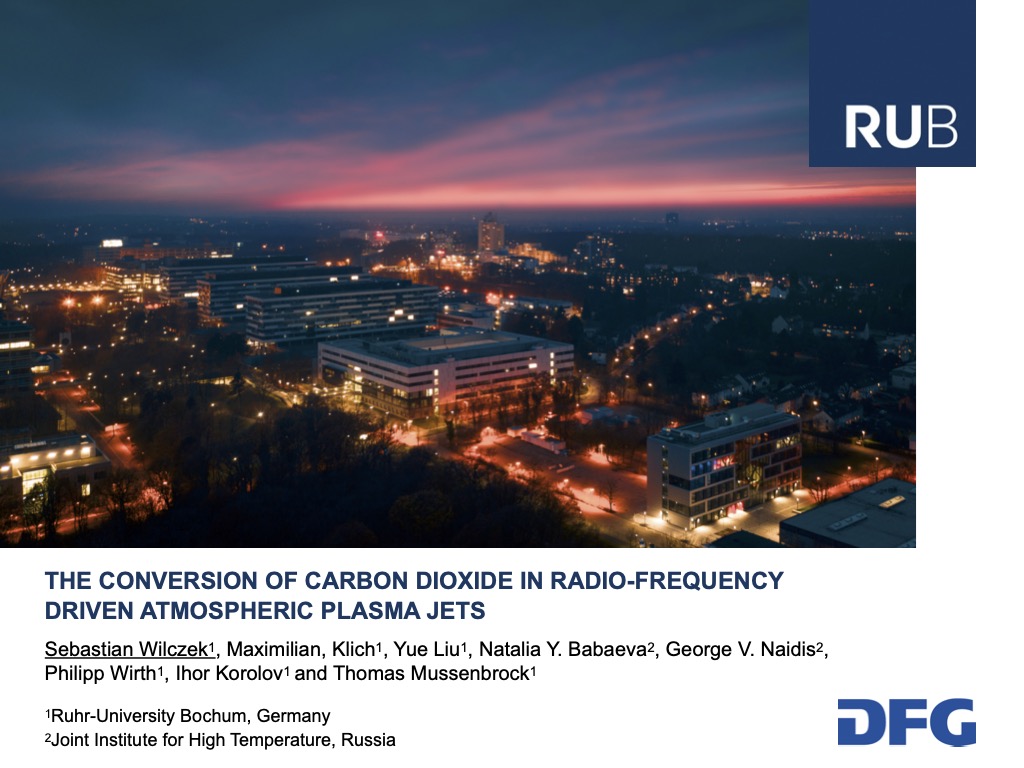
Abstract:
One of the biggest challenges at present is the recycling of greenhouse gases into valuable chemicals and new fuels by using renewable energy sources. In the field of low-temperature plasmas, the energy-efficient splitting of carbon dioxide is a current research topic. In contrast to thermal conversion, plasma-based conversion can control the electron energy distribution function, and thus, the dissociation pathway of carbon dioxide. In this work, a radio-frequency driven microscopic atmospheric plasma jet (COST reference jet) is used to investigate the dynamics of reactive and charged species through a 30 mm long discharge channel with a quadratic cross-section of 1 square millimeter. In addition to carbon dioxide, helium is included as a co-reactant gas in order to sustain the plasma through the channel. The validity of the chemistry data set is investigated by global and plug flow models using globalKin. Next, 2D fluid simulations with the computer program nonPDPSIM are performed for different discharge conditions, e.g., gas flow rate, driving voltage and applied frequency. Both simulation models are developed by Mark Kushner from the University of Michigan. The dynamics of the charged particles, as well as the dynamics of the conversion process, are analyzed on their different timescales. In addition to the simulation work, experimental measurements provide first impressions about the agreement of the results.
2021
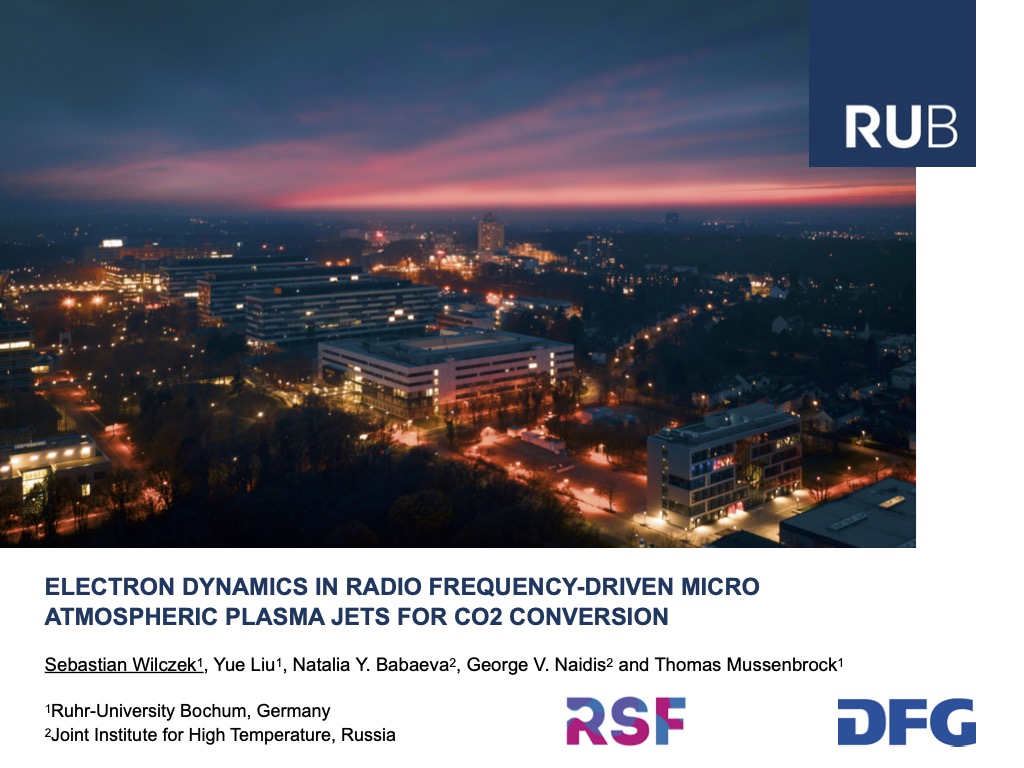
Abstract:
The CO2 conversion into CO and O2 is a current research topic in the low temperature plasma community. In contrast to thermal conversion, radio frequency plasmas at atmospheric pressures are able to control the electron energy distribution function, and thus, the dissociation pathway of CO2 (excitation of vibrational levels). In this work, the CO2 conversion efficiency in a radio frequency driven microscopic atmospheric pressure plasma jet is studied. Different co-reactant gases, such as argon and helium, are applied in order to improve the CO2 conversion process. The validity of the chemistry data set is investigated by global and plug flow models using globalKin simulations. Subsequently, 2D fluid simulations with nonPDPSIM are performed to study the plasma and gas dynamics in the COST reference plasma jet. Both simulation models are developed by Prof. Mark Kushner from the University of Michigan. In particular, the effect of the power coupling to the electrons in combination with the chosen co-reactant gas is to demonstrate that an energy-efficient channel for CO2 dissociation can be provided.
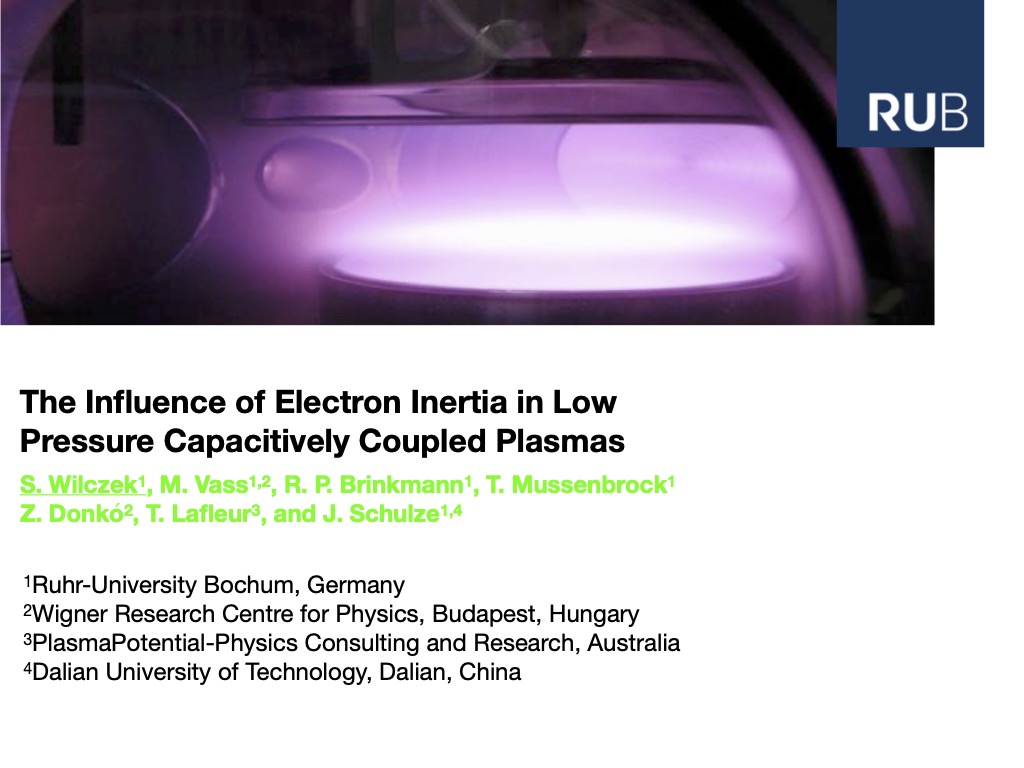
Abstract:
Low pressure capacitively coupled radio frequency discharges (CCRF) offer a variety of technological applications, such as plasma etching in semiconductor technology and plasma sputtering in coating technology. An essential role plays the electron dynamics, which is fundamental for the ionization process and the generation of radicals, and thus, influences the resulting particle distribution on the surfaces (e.g., of a substrate). In the low pressure regime, electrons gain most of their energy during sheath expansion and traverse a certain distance collisionlessly through the plasma bulk. These nonlocal dynamics leads to a pronounced anisotropy in the electron velocity distribution function. Especially in the region of the plasma sheath edge, this anisotropy can lead to a nonlinear interplay between the sheath and the bulk, which in turn causes excitation of higher harmonics in the RF current (excitation of the plasma series resonance). Predominantly in geometrically asymmetrical CCRF discharges, the harmonics exhibit pronounced amplitudes that strongly influence the electron power absorption. In this work, the electron power absorption in geometrical asymmetric CCRF discharges (cylindrical electrodes) is investigated using 1d3v Particle-In-Cell/Monte Carlo Collision simulations. The analysis of the momentum balance equation (Boltzmann term analysis) indicates the influence and the importance of electron inertia in order to sustain a discharge via ionization at very low pressure conditions.
Abstract:
Understanding electron power absorption in low temperature plasmas is of great importance due to their numerous industrial applications. One of the main power absorption mechanisms, ubiquitous to all types of plasma, is Ohmic heating. The electron momentum loss, fundamental to its calculation, is usually approximated using the collision frequency. In this work, the electron momentum loss obtained from PIC/MCC simulations, and the classical approximation based on the electron-neutral collision frequency, are calculated and compared in low pressure CCPs in various gases. We find that the classical approximation, commonly used in fluid models, exaggerates the role of low-energy electrons and can lead to a significantly lower momentum loss compared to the exact value, even if the exact electron distribution function is known. This leads to an underestimation of the Ohmic power absorption and a change in the harmonic content of the momentum loss. For gases with a Ramsauer-Townsend minimum (e.g. argon), the classical approximation is found to be particularly poor due to the decreased number of collisions for low energy electrons. This is confirmed by using a ``fake'' argon gas where the Ramsauer-Townsend minimum is artificially removed. The results are of broad general relevance to low-temperature plasmas, and can be useful for assessing errors in plasma fluid models *This work was funded by the German Research Foundation in the frame of the project No. 428942393.
Abstract:
In contrast to low-pressure plasmas, where the Debye length λ D and the discharge length L differ by several orders of magnitude, many atmospheric pressure plasmas inherit comparable scales for these quantities. As a result of this characteristic, atmospheric pressure plasmas can fail to develop a quasi-neutral bulk region and operate within a non-neutral discharge regime. We observe and analyze this operation regime by applying a one-dimensional hybrid particle-in-cell/Monte Carlo collisions (PIC/MCC) simulation for the cross-section of the jet. The results indicate that the electrons become organized within a soliton-like Gaussian-shaped structure. Their dynamics are dominated by the dynamics of this soliton structure, for which a naive analytical model was developed. Furthermore, a direct comparison between the analytical model and the simulation results is achieved that validates the conclusions drawn.
Abstract:
The idea of re-using CO2 and transforming it into valuable chemicals has been gaining increasing interest in recent years. Plasma-assisted CO2 dissociation offers one possible solution to this problem. In this contribution, we report on the results from a 2-dimensional computational investigation of the CO2 conversion to CO and oxygen in an atmospheric pressure microwave (MW) plasma torch device. The mixtures of CO2 with Ar and other gases are considered. The parameters that are varied is MW power, CO2 and CO2/Ar flow rates. The optimal operation conditions for CO2 dissociation as a function of these and other parameters are investigated. The achieved energy efficiency is evaluated and compared with available information for other plasma sources. In this study, the two-dimensional nonPDPSIM modeling platform was used which was developed in the group of Prof. Mark J. Kushner (University of Michigan). *The work has been supported by the Joint project between the Russian Science Foundation (Grant 21-42-04420) and DFG Research Grant No. 445072286
Abstract:
Identifying and understanding the main pathways of carbon dioxide dissociation is an important step towards efficient plasma-based CO2 conversion. Here, the step-wise vibrational excitation by electron impact, found in non-equilibrium plasmas, has shown great potential. At the Institute of Space Systems (IRS), the capability of the inductively coupled plasma source IPG4 (Inductive Plasma Generator 4) for effective carbon dioxide dissociation is under investigation. IPG4 is a high-power (160kW) plasma source operating at reduced pressure (2600Pa). In this work, the kinetic model globalKin is used to analyze the CO2 conversion efficiency of the plasma source IPG4. The simulation code is developed by Prof. Mark Kushner from the University of Michigan. The built-in plug-flow model of globalKin allows for a one-dimensional analysis of the reaction kinetics in the CO2 plasma. The role of vibrational excitation in carbon dioxide dissociation is studied. Moreover, the effect of dilution with argon and nitrogen on the reaction kinetics is examined. *The authors want to express their gratitude to the German Academic Scholarship Foundation (Studienstiftung des Deutschen Volkes), the Friedrich und Elisabeth Boysen-Stiftung and the German Research Foundation (Project No. 445072286) for the financial support of this work.
Abstract:
For High Aspect Ratio (HAR) plasma etching capacitively coupled plasmas are operated at pressures below 1 Pa, at low driving frequencies of a few 100 kHz, and at very high voltage of about 10 kV to realize high energy and vertical ion bombardment at the wafer. To enhance the ion flux a second higher frequency in the range of several 10 MHz is often added. Due to the high driving voltage and the low pressure, charged particles, i.e. ions and secondary electrons, can gain extremely high energies of up to 10 keV inside the sheaths. Non-local kinetic effects are important and, thus, computational investigations require the use of PIC/MCC simulations. However, the long RF period and the presence of extremely energetic electrons, which must be traced correctly, leads to a very high number of time steps per RF period and, thus, to computational challenges. Here, we use GPU based 1d3v PIC/MCC simulations including a realistic plasma-surface interaction model to study such plasmas. We include energy dependent and material specific heavy particle and electron induced secondary electron emission coefficients for SiO2 and Si. The spatio-temporal electron dynamics is analyzed and a strong influence of the secondary electron emission properties of the electrode surfaces on the charged particle dynamics is found, especially in the case of unequal electrode materials. Based on this fundamental understanding, we use different tailored driving voltage waveforms (peaks- and square-waveforms) to customize the electron dynamics in the vicinity of the wafer. By minimizing the duration of the local sheath collapse, we generate and control electric field reversals that accelerate electrons towards the wafer to very high energies. In this way we realize vertical high energy bombardment of the wafer both by ions and electrons. Such electrons can penetrate deeply into dielectric HAR etch features to neutralize wall charges. In this way parasitic effects such as twisting, notching, and mask charging can be avoided.
Abstract:
Low temperature capacitively coupled RF plasma sources (CCPs) are of paramount importance for a wide range of industrial applications of high societal relevance. A fundamental understanding of the underlying physical principles which control these processes is vital for a knowledge-based process development. One important question to be answered is how electrons gain and lose their energy within the plasma (i.e. electron power absorption). In this work, a self-consistent, spatio-temporally resolved analysis of the electron power absorption dynamics is presented for various gases and discharge conditions. The analysis is based on the first velocity moment of the Boltzmann-equation using information taken from 1d3v Particle-In-Cell/Monte Carlo Collision simulations. In order to obtain a full understanding, the total electron power absorption is divided into three different mechanisms: “intertial”, “pressure” and “Ohmic” power absorption. While investigating (electropositive) argon and (electronegative) oxygen, we revisit some of the well-known models of electron power absorption (“collisionless/stochastic heating” and “Ohmic heating”), and show that they provide an incomplete description and might lead to misleading results. We show that rather counterintuitively, “Ohmic” power absorption is dominant at low pressure in oxygen, and also in argon under specific conditions, and offer an explanation based on the Boltzmann term analysis. We investigate the effect of secondary electrons on the electron power absorption dynamics and analyse the complex non-local dynamics of energetic secondary electrons at low pressure.
2020
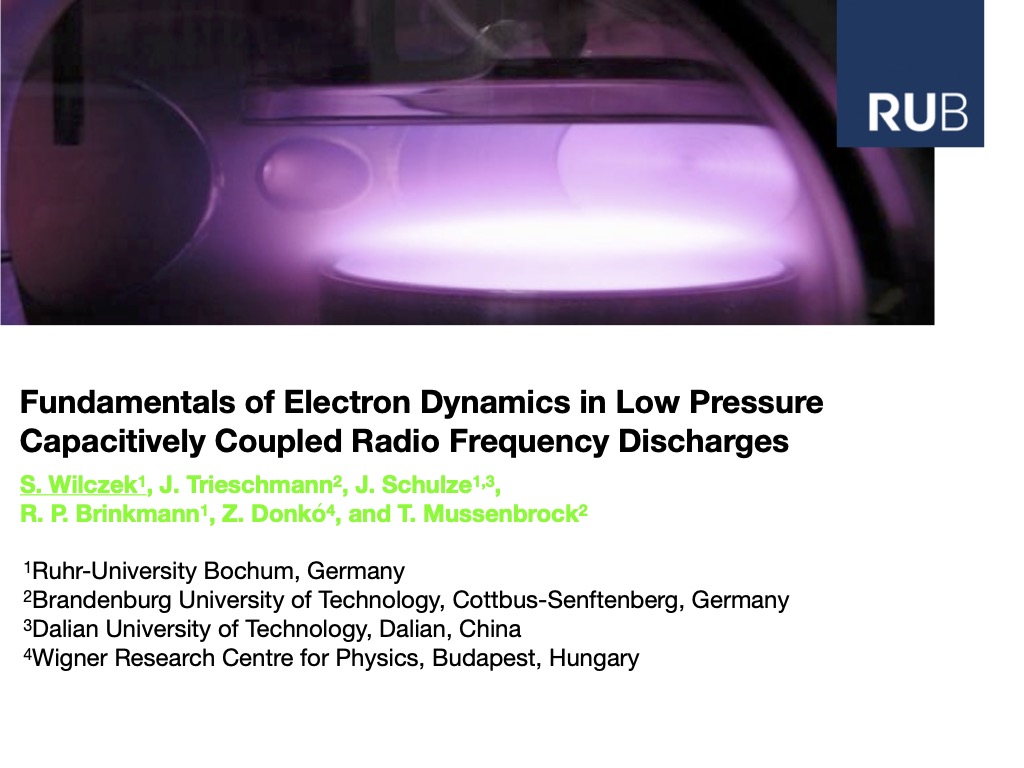
Abstract:
Capacitively coupled radio frequency (CCRF) discharges are indispensable tools for the semiconductor and coating technologies. At low pressures, the discharge operates in a very ‘nonlocal’ regime. Electrons interact with the space- and time dependent electric field and traverse a certain distance (electron mean free path) collisionlessly. Consequently, the local electron velocity distribution function becomes anisotropic and the discharge exhibits complex electron dynamics, such as nonlinear effects and resonance phenomena. In the last 50 years, various terminologies have been introduced which are based on theoretical, experimental and computational work in order to study the electron power absorption at low pressure, e.g., stochastic heating, nonlinear electron resonance heating, pressure heating, ambipolar heating, wave-particle-heating and many more. It is not the aim to give an overview of all these previous approaches, but to introduce a basic strategy for the analysis of the dynamics of electrons for a universal electropositive CCRF discharge scenario (3 Pa, argon). 1D3V Particle-in-Cell / Monte Carlo Collisions (PIC/MCC) simulations provide spatio-temporal diagnostic methods in order to illustrate the interplay between the fundamental plasma parameters, such as densities, fields, currents and temperatures. An analysis of the complete momentum balance equation1 is introduced to explain in detail, how the electron power absorption in a low pressure CCRF discharge really works.
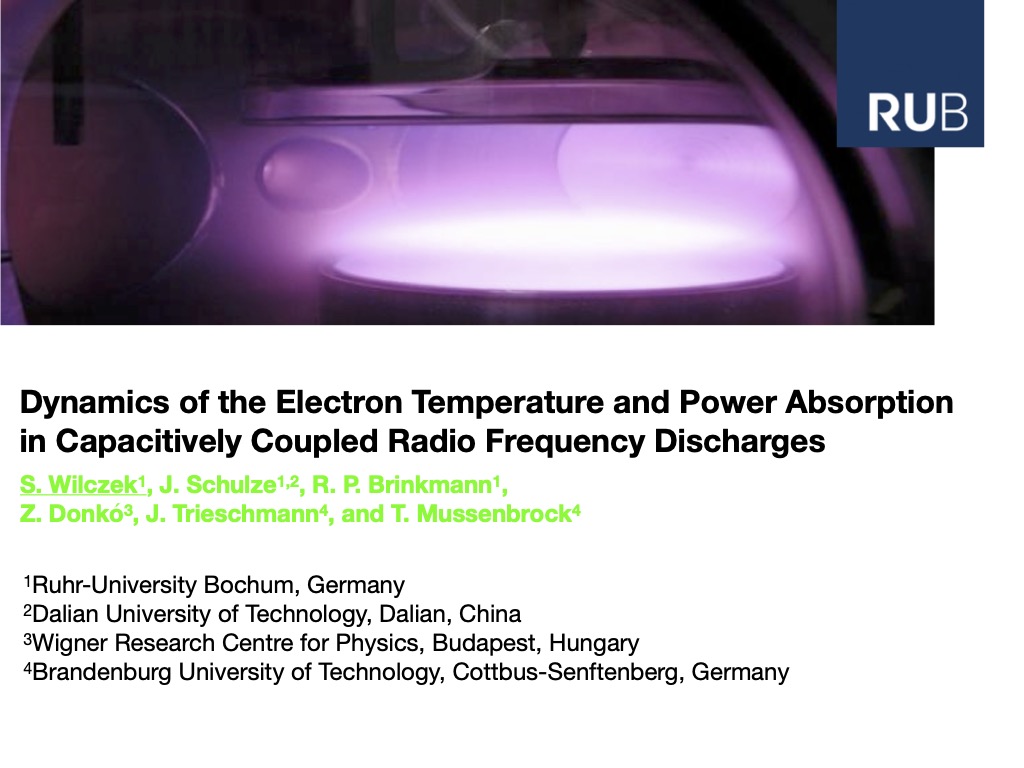
Abstract:
In low pressure capacitively coupled radio frequency (CCRF) discharges, the optimization of technological processes, such as sputtering, etching and plasma enhanced chemical vapor deposition requires an essential understanding of the electron dynamics. This is because electrons with a specific energy threshold, e.g., ionization energy, are responsible for the generation of positive ions and radicals. Therefore, the two most important questions in low pressure CCRF discharges are, how do the electrons gain and loss their energy during one radio frequency cycle1 and what is a typical electron temperature? The first issue is frequently studied as ‘electron power absorption’ which can be determined by the product of the electric field and the electron current density. Spatio-temporal results show that most of the power absorption is observed at the plasma sheath edge as well as in front of the plasma sheath where a temporally constant ambipolar electric field arises. The second question deals with the electron temperature which is determined by the thermodynamic relation and lies usually between 1 and 5 eV. However, the classical concept of the electron temperature indicates some limitations, because in such a low pressure regime the local electron velocity distribution function is very anisotropic, especially during sheath expansion. In this work, a concept of a kinetic temperature is introduced which distinguishes the temperature into different directions (parallel and perpendicular to the electrode surface). This concept shows that collision events are essential in order to transfer thermal energy between the different directions. Finally, the temperature shall be linked to the electron power absorption to show that heating (change in the temperature) and electron power absorption are two different physical mechanisms. The presented spatio-temporal results are obtained by means of 1D3V Particle-in-Cell / Monte Carlo Collisions (PIC/MCC) simulations.
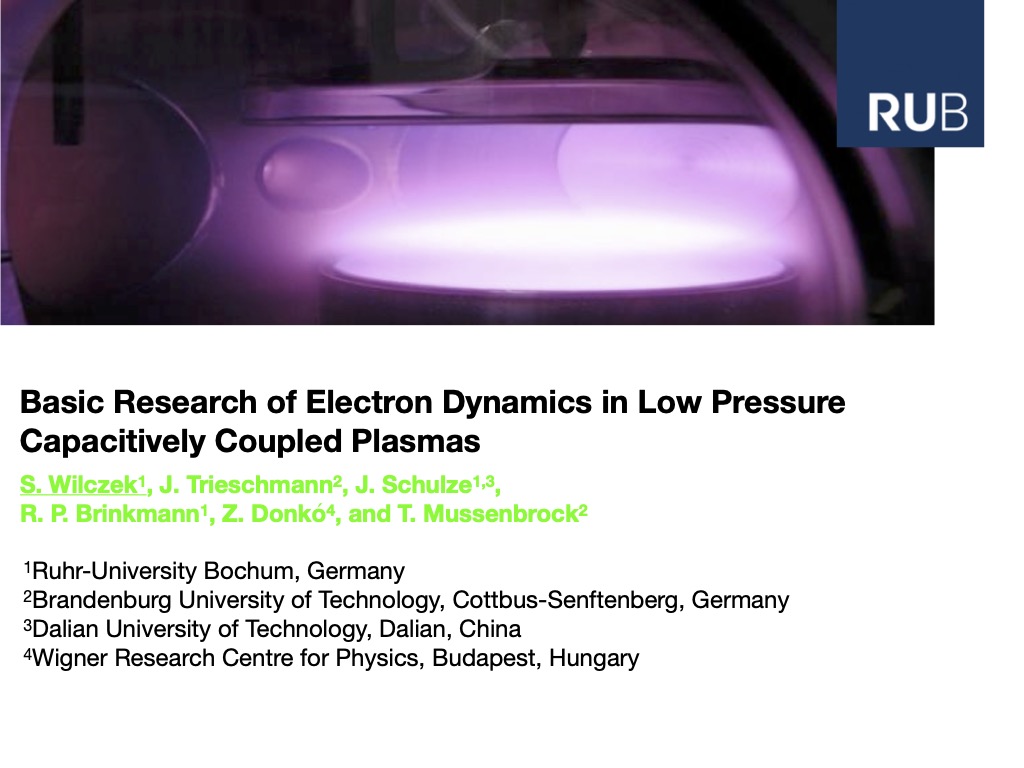
Abstract:
At low pressures, capacitively coupled radio frequency (CCRF) discharges operate in a ‘nonlocal’ regime. Electrons interact with the space- and time dependent electric field and traverse a certain distance without any collisions. Consequently, the electron velocity distribution function becomes anisotropic and the discharge exhibits complex electron dynamics, such as nonlinear effects and resonance phenomena. In the last decades, various terminologies have been introduced which are based on theoretical, experimental and computational work in order to study the electron power absorption at low pressure, e.g., stochastic heating, nonlinear electron resonance heating, pressure heating, ambipolar heating, wave-particle-heating, bounce-resonance-heating and many more. All describe the same mechanism, the energy gain and loss of electrons in a space- and time-varying electric field. The goal of this work is to demonstrate a basic strategy of how to investigate the electron dynamics for a universal electropositive CCRF discharge scenario (3 Pa, argon). 1D3V Particle-in-Cell / Monte Carlo Collisions (PIC/MCC) simulations provide spatio-temporal diagnostic methods (educational animations) in order to illustrate the interplay between the fundamental plasma parameters, such as densities, fields, currents and temperatures. The analysis shows how current conservation is ensured and how it is linked to the generation of electrostatic waves. Electron distribution functions are discussed and the importance of energetic beam-like electrons is addressed. All terms of the momentum balance equation are calculated self-consistently in the PIC/MCC simulation to explain in detail, how the electron power absorption in a low pressure CCRF discharge really works.
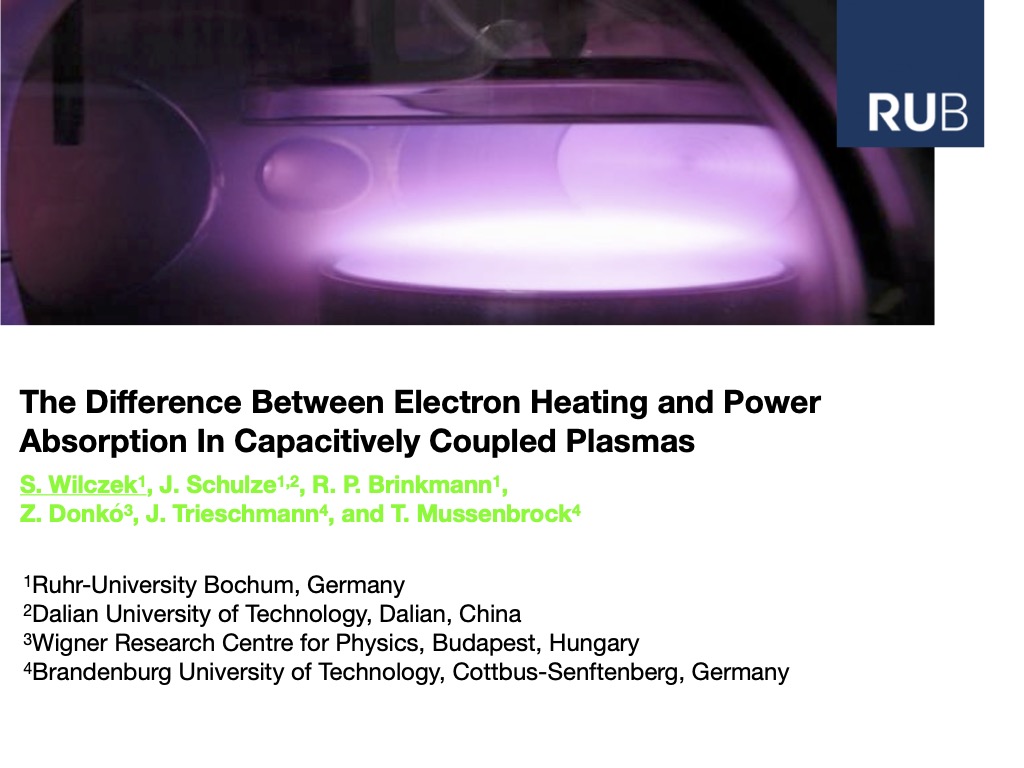
Abstract:
In low pressure capacitively coupled radio frequency (CCRF) discharges, the optimization of technological processes, which range from semiconductor manufacturing to atomic layer deposition and biomedical/environmental applications, is important. All of them require a basic understanding of the electron dynamics. This is because electrons with a specific energy threshold, e.g., the ionization energy, are responsible for the generation of ions and radicals. Therefore, the two important questions in low pressure CCRF discharges are, how do the electrons gain and loss their energy during one radio frequency cycle and what is a typical electron temperature? The first issue is frequently studied as ‘electron power absorption’ which can be determined by the product of the electric field and the electron current density. Spatio-temporal results show that most of the power absorption is observed at the plasma sheath edge. The second question deals with the electron temperature which is determined by thermodynamics and is usually between 1 and 5 eV. However, the classical concept of the electron temperature has some limitations, because in such a low pressure regime the electron velocity distribution function is very anisotropic, especially during sheath expansion. In this work, a concept of a kinetic temperature is introduced which distinguishes the temperatures in different directions (parallel and perpendicular to the electrode surface). This concept shows that collision events are essential in order to transfer thermal energy between the different directions. Finally, the temperature shall be linked to the electron power absorption to show that heating (change in the temperature) and electron power absorption are two different physical mechanisms. The presented spatio-temporal results are obtained by means of 1D3V Particle-in-Cell / Monte Carlo Collisions (PIC/MCC) simulations.
Abstract:
In capacitively coupled radio frequency (CCRF) discharges, the expanding plasma sheath generates electrostatic waves which propagate through the plasma bulk. This wave propagation is frequently evidenced in Particle-In-Cell / Monte Carlos collisions (PIC/MCC) simulations in the low pressure regime (p ~ 1 Pa) by the spatio-temporal distribution of the displacement current density. By considering ion induced secondary electron emission, electrons are generated at the plasma boundary surface and are accelerated by the RF-oscillating sheath electric field. This leads to a stronger excitation of the waves, in which the amplitude of the displacement current density increases by raising the secondary electron (SE) emission yield. In addition, the dynamics of the SEs are also coupled with the wave propagation. By including SEs, a particular spatio-temporal ionization structure develops in which the velocity corresponds to that of the electrostatic wave and intensifies the ionization process. In this low pressure regime the beam of SEs can bounce multiple times through the discharge and lead to nonlocal effects, especially at the boundary sheaths. In order to study this phenomenon, 1d3v PIC/MCC simulations of a symmetric CCRF discharge are performed.
Abstract:
By Particle-In-Cell/Monte Carlo collision simulations of capacitive RF discharges operated in argon at low pressure and at high voltages, we demonstrate that tailoring the driving voltage waveform allows to generate high fluxes of energetic electrons towards one of the electrodes. These electrons impinge vertically on the wafer with velocities well above 3 ×106 m / s and can, thus, penetrate deeply into high aspect ratio etch features to compensate positive surface charges inside these structures. This is achieved by generating electric field reversals during sheath collapse at the wafer by tuning the driving voltage waveform. The effects of the peak-to-peak voltage, number of harmonics, and the duty-cycle on the electron velocity distribution at the wafer are clarified for peaks-, valleys-, and square-shape-waveforms. Project funded by: Samsung Electronics University R and D program, China Scholarship Council (No. 201906060024), Hungarian Grant K-119357, K-134462 and FK-128924, Janos Bolyai Research Scholarship of the Hungarian Academy of Sciences, German Research Foundation via MU 2332/6-1.
Abstract:
The Smooth Step Model (SSM) establishes an approximate closed-form expression for the spatially and phase-resolved electric field in an RF-modulated plasma boundary sheath. The model takes thermal (finite electron temperature) and dynamic (finite electron mass) effects into account in leading order perturbation theory. It provides (i) the space charge field in the electron-depleted sheath, (ii) the generalized Ohmic and ambipolar field in the quasineutral plasma, and (iii) a smooth interpolation for the transition in between. This contribution compares the Smooth Step Model with a outcome of a self-consistent Particle-in-Cell/Monte Carlo Collisions simulation of a capacitive RF plasma (argon at 3 Pa/13.56 MHz). It is found that the maximal relative deviation of the local field is (as expected) in the percentage range. The error for the integrated field, i.e., the sheath voltage, is below one percent. *Deutsche Forschungsgemeinschaft DFG via SFB 1316
Abstract:
The boundary sheath of a low temperature plasma comprises often only a fraction of its volume but is responsible for many aspects of the macroscopic behavior. Reliable models of the sheath are therefore of theoretical and practical interest. Particularly interesting are ''algebraic'' models which describe the particle densities and the electrical field of the sheath in closed analytical form. This contribution presents an algebraic model of the RF modulated boundary sheath which applies for a wide range of excitation waveforms and amplitudes, and levels of collisionality. A comparison with the results of a kinetic Particle-in-Cell/Monte Carlo Collisions simulation is conducted. *Deutsche Forschungsgemeinschaft DFG via SFB 1316 and RUB Research School.
2019
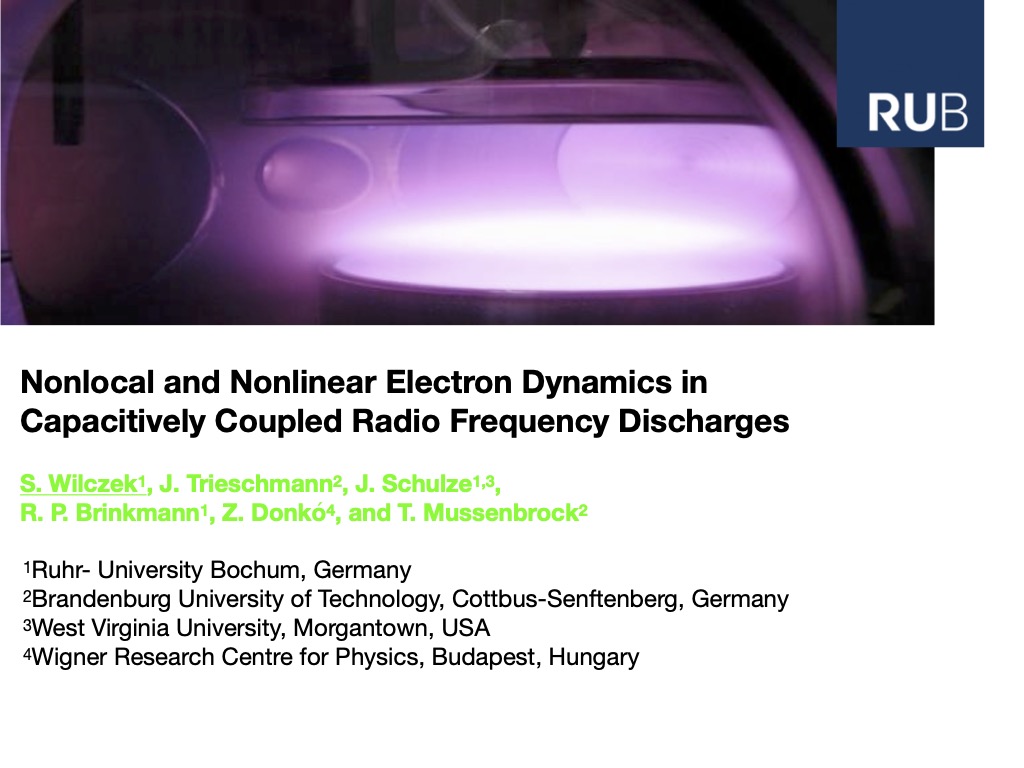
Abstract:
Kapazitiv gekoppelte Hochfrequenzentladungen (CCRF) im Niederdruckbereich bieten eine Vielzahl von technischen Anwendungen, wie beispielsweise das Plasmaätzen in der Halbleitertechnik sowie das Plasmazerstäuben in der Beschichtungstechnologie. Eine essentielle Rolle in diesen Entladungen spielt die Elektronendynamik, welche für Ionisationsprozesse grundlegend ist und somit die resultierende Ionenverteilung an den Oberflächen (z.B. eines Substrats) beeinflusst. Im Druckbereich von 0,1 bis 10 Pascal weisen Elektronen eine mittlere freie Weglänge auf, welche teilweise größer als die Systemlänge (Plattenabstand der Elektroden) ist. In diesem ‚nichtlokalen‘ Regime gewinnen Elektronen ihre Energie im Wesentlichen durch die Expansion der Plasmarandschichten. Dies führt dazu, dass sich die Elektronen gerichtet (als Elektronenbeam) und nahezu stoßfrei durch den Plasmabulk bewegen. Anschließend findet eine erneute Interaktion mit der gegenüberliegenden Randschicht statt, wobei der Auftreffzeitpunkt des Elektronenbeams mit der Randschichtphase eine entscheidende Rolle spielen kann [1]. Ist der Auftreffzeitpunkt während der kollabierenden Phase der Randschicht, verlieren die Elektronen effektiv Energie, da sie durch das zeitlich sinkende Randschichtpotential abgebremst werden. Zusätzlich können die hochenergetischen Beamelektronen vor allem zum Zeitpunkt des Randschichtkollaps das Randschichtpotential überwinden und an der Elektrode samt ihrer Energie verloren gehen. Die Einschlussgüte (Confinement) des Elektronenbeams kann jedoch mit einer geeigneten Parameterwahl von Anregungsfrequenz, Plattenabstand der Elektroden und Gasdruck eingestellt werden, wobei die Plasmadichte um bis zu zwei Größenordnungen variieren kann. Ein weiterer wichtiger Mechanismus bei niedrigen Drücken ist die ‚nichtlineare‘ Elektronendynamik, welche größtenteils in geometrisch asymmetrischen Entladungen (unterschiedliches Flächenverhältnis von geerdeter und getriebener Elektrode) ausgeprägt ist und experimentell durch hochfrequente Oszillationen im Strom an der Elektrode nachgewiesen werden kann. Hier fällt der Dynamik der Elektronenbeams ebenfalls eine zentrale Rolle zu. Durch das Eindringen eines Beams in den Plasmabulk kann eine elektrische Feldumkehr im Bereich zwischen Randschicht und Bulk entstehen, welche Elektronen des Bulks zurück zur Randschicht beschleunigt und somit für die Entstehung von höheren Frequenzkomponenten im HF Strom verantwortlich ist [2]. Darüber hinaus können mehrere Elektronenbeams während einer Randschichtexpansion erzeugt werden, die den Ionisationsprozess maßgeblich verstärken können [3]. Dieser Beitrag liefert anhand von 1d3v Particle-In-Cell / Monte Carlo Collisions (PIC/MCC) Simulationen einen fundamentalen Einblick in die ‚nichtlineare‘ und ‚nichtlokale‘ Elektronendynamik von CCRF Entladungen. Mit dem Verständnis kann gezeigt werden, dass die Dynamik der Elektronen auf der Zeitskala von Nanosekunden gesteuert und optimiert werden kann, während hierbei die Gesamtdynamik der Entladung maßgeblich beeinflusst wird. Referenzen [1] S. Wilczek et al., Plasma Sources Sci. Technol., 24, 024002 (2015) [2] S. Wilczek et al., Phys. Plasmas, 23, 063514 (2016) [3] S. Wilczek et al., Plasma Sources Sci. Technol., 27, 125010 (2018)
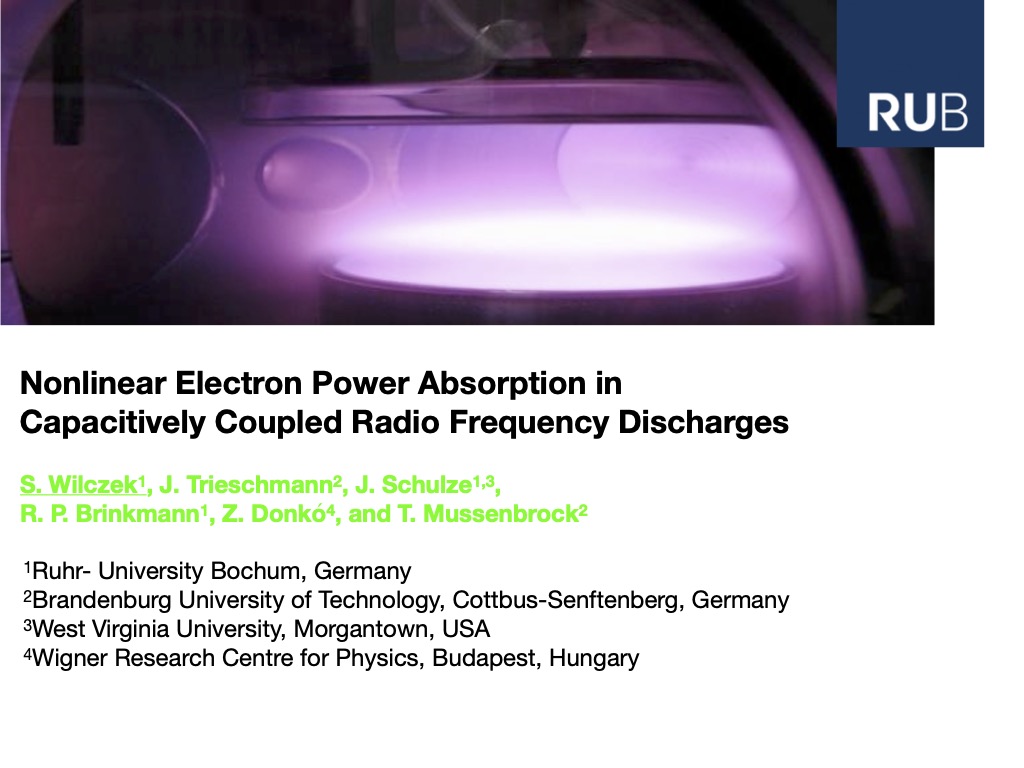
Abstract:
In low pressure capacitively coupled radio frequency (CCRF) discharges, the expansion of the plasma sheaths generate highly energetic electron beams traversing the discharge gap and supporting the plasma via ionization. The penetration of these electrons into the plasma bulk can lead to significant plasma oscillations and propagation of electrostatic waves. Consequently, the electron power absorption as well as the RF current indicate significant nonlinear dynamics in the low pressure regime. In this work, we investigate the nonlinear electron power absorption by means of 1d3v Particle-In-Cell / Monte Carlo Collisions (PIC/MCC) simulations in geometrically symmetric and asymmetric CCRF discharges. Pronounced electron power gain and loss dynamics are observed in the region between the plasma bulk and the plasma sheaths during the phase of sheath expansion. Oscillations observed in the RF current — which is a global parameter that can be easily measured by a current probe in an experiment — can be clearly attributed to these discharge dynamics.
Abstract:
The etching of sub micrometer high-aspect-ratio (HAR) features into dielectric materials in technological radio frequency plasmas is limited by the accumulation of positive surface charges inside etch trenches, causing reduced etch rates and feature deformations. These charge effects are, at least partially, caused by a difference in angle and velocity distributions of ions and electrons. Here, we demonstrate that using Voltage Waveform Tailoring, electric field reversals adjacent to the wafer can be generated and used to accelerate electrons into HAR features and compensate positive surface charges. Based on 1d3v Particle-in-Cell/Monte Carlo simulations of a capacitively coupled plasma operated in argon at 1 Pa, we study the effects of different voltage waveforms on this electric field reversal as well as on the electron velocity and angular distribution function at the wafer. We find that the angle of incidence of electrons relative to the surface normal can be strongly reduced and the electron velocity perpendicular to the wafer can be significantly increased by choosing appropriate waveforms. This work was supported by the US NSF (Grant No. PHY1601080) and by the German Research Foundation (DFG) within the frame of the collaborative research center SFB-TR 87 (project C1 and C8 and project MU 2332/6-1.
Abstract:
Active Plasma Resonance Spectroscopy (APRS) denotes a class of industry-compatible plasma diagnostic methods which utilize the natural ability of plasmas to resonate on or near the electron plasma frequency. One particular realization of APRS with a high degree of geometric and electric symmetry is Multipole Resonance Probe (MRP). The Ideal MRP (IMRP) is an even more symmetric idealization which is suited for theoretical investigations. In this work, a spectral kinetic scheme is presented to investigate the behavior of the IMRP in the low pressure regime. The proposed kinetic model overcomes limitation of the cold plasma model and covers kinetic effects such as collisionless damping. Most importantly, it provides the possibility to calculate both the electron temperature and electron density from measured resonance curves.
Abstract:
The power absorption in electronegative CCPs at low pressures indicates complex electron dynamics that are still not fully understood. Therefore we present a spatio-temporally resolved analysis of electron power absorption in low pressure oxygen CCPs based on the first two moments of the Boltzmann-equation. The spatio-temporal results are obtained self-consistently from 1d3v Particle-In-Cell / Monte Carlo Collision simulations. In contrast to typical theoretical models of electron heating, we observe significant ohmic heating and an attenuation of ambipolar heating at low pressures due to the strong electronegativity of the discharge.
Abstract:
The generation of secondary electrons (SEs) in low pressure capacitively coupled radio frequency (CCRF) discharges is one part of the plasma surface interaction which strongly affects the electron dynamics. However, SEs, in particular electron induced SEs (δ-electrons), are frequently neglected in theory and simulations. Especially at small gap sizes and high sheath voltages, the δ-electrons dominate the ionization process and can significantly increase the plasma density. With the separation of γ-electrons and δ-electrons, the electron power gain as well as the generation of each species can be understood on a nanosecond timescale. In order to study this issue, 1d3v particle-in-cell/Monte Carlo collisions (PIC/MCC) simulations of a symmetric CCRF discharge are performed in the low pressure regime (p 1 Pa). In this work, the gap size is varied and the effects of the nonlocal and nonlinear dynamics of γ-electrons and δ-electrons on the discharge are investigated by using a realistic model for the electron-surface interactions. It is shown, that particularly for small gap sizes the δ-electrons dominate the discharge population of electrons in the range of 50%.
Abstract:
In low pressure capacitively coupled radio frequency (CCRF) discharges, secondary electrons (SEs), in particular, electron induced SEs (δ-electrons) are frequently neglected in theory and simulations. The generation of SEs in low CCRF discharges is one part of the plasma surface interaction, which strongly affects the electron dynamics. Especially at small gap sizes and high sheath voltages, the δ-electrons dominate the ionization process and can significantly increase the plasma density. Generally, the generation of δ-electrons depends on the dynamics of ion induced SEs (γ-electrons) due to their very high energies. Therefore, it is important to consider the dynamics of the different electrons (δ-electrons and γ-electrons) separately. With this separation, the electron power gain and loss as well as the generation of each species can be understood on a nanosecond timescale. In order to study this issue, 1d3v particle-in-cell/Monte Carlo collisions (PIC/MCC) simulations of a symmetric CCRF discharge are performed in the low pressure regime (p ≈ 1 Pa). In this work, the gap size is varied and the effects of the nonlocal and nonlinear dynamics of γ-electrons and δ-electrons on the discharge are investigated by using a realistic model for the electron-surface interactions in the simulations. It is shown, that particularly for small gap sizes the δ-electrons dominate the discharge population of electrons in the range of 50% and lead to the generation of multiple SE beams during one RF period.
2018

Abstract:
In capacitively coupled radio frequency (CCRF) discharges at low pressures, the electron power gain is dominated by electron interaction with the plasma sheath. During sheath expansion a bunch of energetic electrons is accelerated into the bulk region and carries energy to sustain the discharge via ionization. Additionally, the penetration of these beam-like electrons into the plasma bulk can lead to a local electric field reversal which leads to a nonlinear interplay between bulk electrons and the expanding sheath. The consequences are higher order oscillations in the RF current as well as the excitation of electrostatic waves. Particularly at low pressures, the electron mean free path is frequently larger than the gap size. In this nonlocal regime, the nonlinear sheath dynamics at one electrode influence the behavior in front of the opposite electrode, i.e., energetic electrons traverse through the discharge almost collisionlessly and interact with the opposing sheath at different phases. Furthermore, the generation of secondary electrons vastly contributes to this mechanism, due to their beam-like behavior at low pressures. In this work, nonlinear and nonlocal dynamics, in particular the electron power gain, are investigated by means of 1d3v PIC simulations of symmetric and asymmetric CCRF discharges.
Abstract:
Active Plasma Resonance Spectroscopy (APRS) denotes a class of industry-compatible plasma diagnostic methods. One particular realization of APRS with a high degree of geometric and electric symmetry is the Multipole Resonance Probe (MRP). The Ideal MRP is an even more symmetric idealization which is suited for theoretical investigations. In this work, a spectral kinetic scheme is presented to investigate the behavior of the Ideal MRP in the low pressure regime. Similar to the particle-in-cell method, the scheme consists of two modules, the particle pusher and the field solver. A Green's function is defined to solve this potential problem. The spherical harmonics is employed to provide a general solution. With suitable truncation of the harmonics expansion, the complexity of the task can be reduced. The proposed kinetic model overcomes limitation of the cold plasma model and covers kinetic effects. Numerical results illustrate the resonance behavior and damping phenomena due to the escape of particles.
Abstract:
For the simulation of plasma processes, in particular, for industrial applications, often suitable collisional input data is not available. In particular, ion-neutral collision cross sections for ions in non-parent gases are frequently unavailable. The purpose of this contribution is to provide solution concepts to remedy this issue. In order to investigate the influence of different collisional interaction approaches on the discharge, we choose a low pressure capacitively coupled argon-xenon discharge. The main advantage of this choice is its relatively simple chemistry which leads to a feasible number of considered reactions. A PIC/MCC simulation is used with two different approaches to the ion-neutral interaction. An approach based on the Langevin formalism and its capture cross section is compared to an approach that builds on a generalized Lennard-Jones potential. We show that different approaches for the interaction between argon ions and xenon neutrals and vice versa can lead to significantly different results. It is shown that even two approaches which are based on physically sound assumptions can lead to considerably different results. It is argued that particular caution is required concerning the choice of input data in these situations. This work is supported by the german research foundation in the frame of the Collaborative Research Center 1316.
Abstract:
Industrial plasma applications require an accurate control of the ion energy at the substrate surfaces. At the same time, these plasmas contain various gas and ion species, which may imply a complex chemistry. The control of the kinetics of multiple gas and ion species is a topic of current research. We investigate a low pressure argon-xenon discharge by means of Particle-In-Cell/Monte Carlo Collision (PIC/MCC) simulations. The advantage of this noble gas mixture lies in its feasible amount of species and a corresponding simple chemistry. A symmetric capacitively coupled radio-frequency (CCRF) discharge is investigated for a variety of discharge parameters. It is found that a separate control of argon and xenon ions cannot unconditionally be achieved under these conditions. This conclusion is drawn from simulated quantities such as the plasma and ion densities, the fluxes toward the surfaces, the discharge energy balance and, in particular, the ion energy distribution functions (IEDFs) at the electrodes. With the obtained knowledge, it is possible to obtain insight into the formation of complex structures in the IEDFs in plasmas with multiple ion species (e.g., influence of charge transfer collisions). This work is supported by the german research foundation in the frame of the Collaborative Research Center 1316.
Abstract:
We investigate the effects of secondary electrons (SEs) induced by electrons on the discharge characteristics in low-pressure single-frequency capacitively coupled plasmas (CCPs) by Particle-in-Cell/Monte Carlo Collisions simulations. Such SEs (δ-electrons) were found to have a remarkable influence on the plasma parameters in argon at 0.5 Pa and 6.7 cm gap between SiO2 electrodes (B. Horváth et al. 2017 Plasma Sources Sci. Technol. 26 124001). Here we study the impact of δ-electrons on the ionization dynamics and plasma parameters at various pressures and voltage amplitudes, assuming different SE yields for ions (γ-coefficient). The voltage amplitude, the gas pressure and the value of the γ-coefficient affect the role of δ-electrons in the ionization dynamics. While their effect is most striking at low pressures, high voltage amplitudes and high γ-coefficients, in the whole parameter regime investigated here the realistic description of the electron-surface interaction changes significantly the computed plasma parameters compared to results based on a widely used simple model for the description of the electron-surface interaction. This work was supported by the US NSF Grant No. PHY 1601080, by the DFG (SFB-TR 87), and Hungarian Grants K-119357 and PD-121033.
Abstract:
The generation of secondary electrons in low pressure capacitively coupled radio frequency discharges is one part of the plasma surface interaction which strongly affects the electron dynamics. However, secondary electrons, in particular electron induced secondary electron emission (eiSEE), are frequently neglected in theory and simulations. Especially at high sheath voltages, previous work has shown that eiSEEs contribute to the ionization process and can significantly increase the plasma density. The generation of eiSEE generally depends on the dynamics of ion induced secondary electron emission (iiSEE) due to their very high energies. Therefore, it is important to consider the dynamics of the different electrons (eiSEE and iiSEE) separately. With this separation, the electron power gain as well as the generation of each species can be understood on a nanosecond timescale. In this work, different parameters (gap size, pressures) are varied by means of PIC/MCC simulations and the impact of iiSEE and eiSEE on the discharge is investigated by using a realistic implementation of surface coefficients.
Abstract:
We present an analysis that provides a detailed understanding of the spatio-temporal electron power absorption dynamics in low pressure electropositive capacitive RF plasmas. The method is based on the moments of the Boltzmann equation, takes input quantities from kinetic PIC/MCC simulations, and does not use any ad-hoc assumptions. It allows the identification of \textit{all} physical mechanisms and an accurate quantification of their contributions. In contrast to some widely accepted previous models we find that high space- and time-dependent ambipolar electric fields outside the sheaths play a key role in the electron power absorption. This ambipolar field is time-dependent within the RF period and temporally asymmetric, i.e., the sheath expansion is not a 'mirror image' of the sheath collapse. This time-dependence is mainly caused by a time modulation of the electron temperature resulting from the energy transfer to electrons by the ambipolar field itself during sheath expansion. This mechanism of electron power absorption, which is markedly different from the Hard Wall Model, is of key importance for energy transfer to electrons on time average and is essential for the generation of capacitively coupled plasmas.
Abstract:
In particle-based simulation studies of low-pressure capacitively coupled plasmas (CCPs), the assumption of a constant ion induced secondary electron emission (SEE) coefficient is typical; this coefficient is independent of the incident particle energy and angle, the electrode material and its surface conditions. The emission of SEs by electron impact and by other plasma species is typically neglected in such simulations. Recent studies emphasize the importance of the realistic description of the SEE in simulations of low-pressure CCPs, as largely different results can be obtained for the same discharge conditions based on different (simple or realistic) descriptions of the various SEE processes. In this work, we perform a systematic investigation of the effects of implementing realistic energy- and material-dependent SE yields for heavy particles and electrons in PIC/MCC simulations of low-pressure CCPs on the plasma parameters and control of ion properties at the electrodes. The simulations cover discharge conditions that are relevant for plasma processing applications of surfaces. This work was supported by the US NSF Grant No. PHY 1601080, by the DFG (SFB-TR 87), and Hungarian Grants K-119357 and PD-121033.
Abstract:
While accurate control of the ion energy is a crucial requirement of industrial plasma processes, its intrinsics are still not fully understood. Specifically, plasmas used for etching or thin film deposition consist of various gas and ion species. Thus, the control of the ion dynamics of multiple gas and ion species is a topic of current research. In order to contribute to this topic, we investigate low-pressure argon-xenon discharges via Particle-In-Cell/Monte Carlo Collision (PIC/MCC) simulations. The main advantage of this noble gas mixture is the simple chemistry, which leads to a feasible number of ion species and collision processes to be considered. The ion energy distribution functions (IEDFs) at the electrodes of a geometrically symmetric capacitively coupled radio-frequency discharge provide information about the ion dynamics within the discharge volume. Several variations of the discharge parameters (e.g., pressure, driving voltage and gas composition) are presented in order to influence the ion dynamics. Furthermore, a power balance model is used, which allows for a better understanding of the obtained results. The final goal of this study is to achieve deeper insights about complex (e.g., bimodal) IEDFs of different ion species.
2017
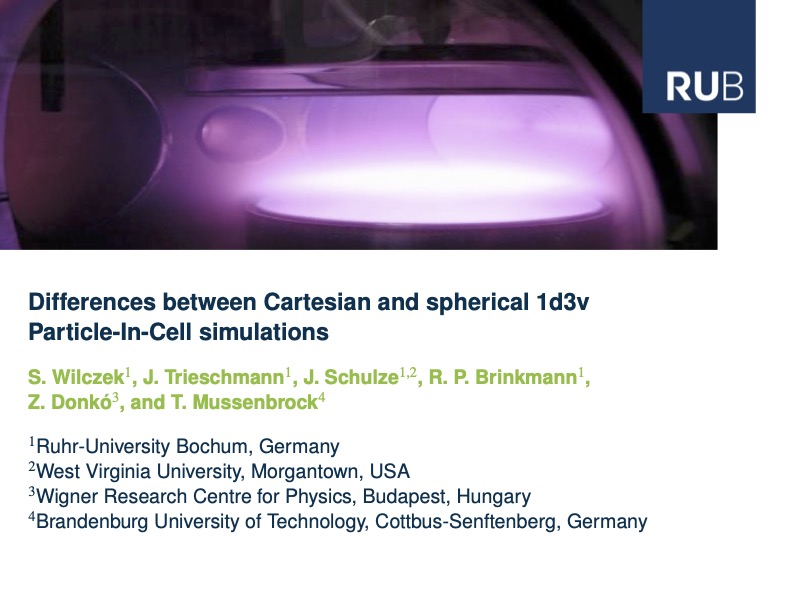
Abstract:
1d3v Particle-In-Cell (PIC) simulations of capacitively coupled radio frequency (CCRF) discharges are usually considered to be symmetric, which implies a Cartesian grid is used. However, in most CCRF systems the driven electrode is smaller compared to the grounded electrode (grounded chamber walls have to be taken into account). In such a situation, different current fluxes at both electrodes can be observed and a DC self-bias develops. The plasma boundary sheaths at the driven and grounded electrode exhibit different dynamics (e.g. sheath potential and sheath size). Especially in very asymmetric scenarios, most of the RF power is coupled into the plasma at the smaller driven electrode. In order to investigate such an asymmetric electrode configuration within 1d3v PIC simulations, a spherical grid is implemented. In this work, the differences between symmetric and asymmetric 1d3v PIC simulations of CCRF discharges are investigated. Particularly, the electron power gain and loss mechanisms (e.g. nonlinear electron resonance heating, power gain due to secondary electrons, ambipolar heating) are studied for different discharge conditions.
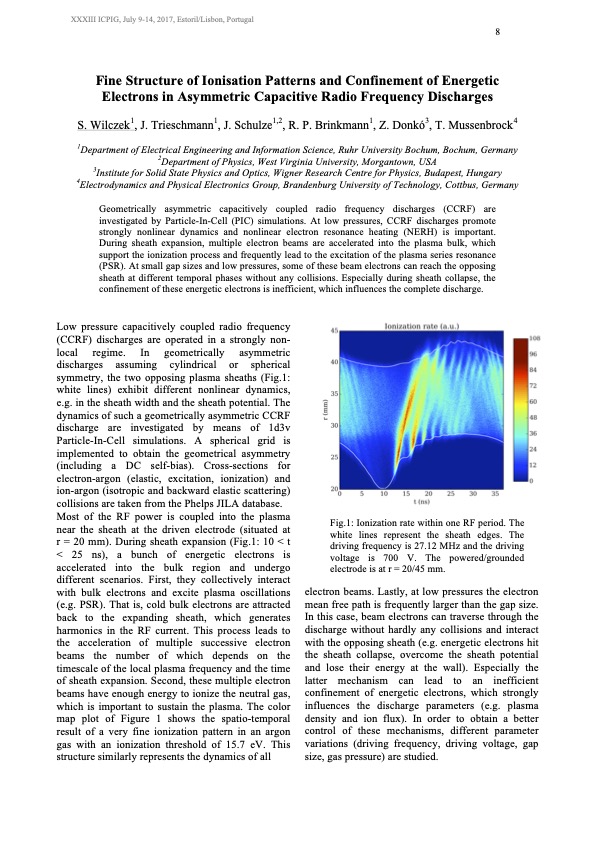
Abstract:
Extended Abstract.

Abstract:
Extended Abstract.
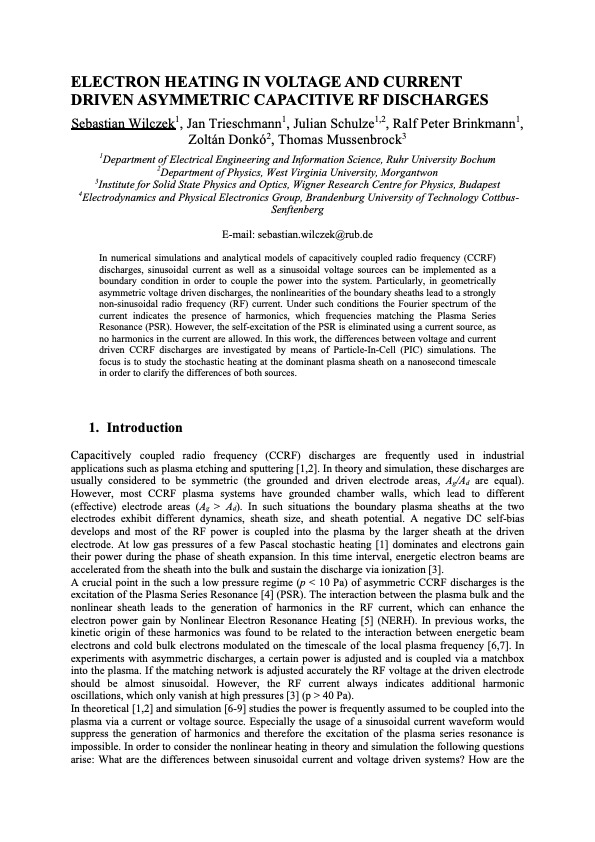
Abstract:
Extended Abstract.
Abstract:
-
Abstract:
Technological plasmas applied for etching or thin film deposition frequently consist of multiple gas and ion species. Accurate control of the ion energy is an essential requirement in these processes. The main goal of this work is to investigate the influence of the gas composition on the ion dynamics within these discharges. A low-pressure argon xenon plasma is chosen and investigated via a Particle-In-Cell/Monte Carlo Collision (PIC/MCC) simulation. The main advantage of this noble gas mixture is its simple chemistry, which leads to a feasible number of ion species to be considered. The ion energy distribution functions (IEDFs) at the electrodes of a geometrically symmetric capacitively coupled radio-frequency (RF) discharge provide information about the ion dynamics within the discharge volume. The cross section of the interaction of argon ions with xenon neutrals is largely unknown. The same holds for the interaction of xenon ions with argon neutrals. For this reason, some model cross sections are assumed and the resulting IEDFs are determined. Additionally, a variation of the gas composition is conducted using different approaches for the Ar-Xe interaction cross sections. Furthermore, we investigate the influence of different discharge parameter (e.g., pressure and driving voltage) on the IEDF and the ion dynamics.
Abstract:
The effects of implementing energy-dependent secondary electron emission coefficients (SEEC) for ions and fast neutrals in PIC/MCC simulations of single and dual frequency capacitive discharges operated in argon are investigated. The surface conditions are taken into account, i.e. clean (heavily sputtered) and dirty (e.g. oxidized) metal surfaces are used. In single-frequency discharges the pressure and voltage at which the transition between the 𝛼- and 𝛾-mode occurs are found to be significantly different compared to simulations based on constant SEECs and to strongly depend on the surface conditions. In classical dual-frequency discharges the effective SEEC significantly increases as a function of the low-frequency voltage amplitude for dirty surfaces due to its effect on the heavy particle energies at the electrodes. This is found to negatively influence the quality of the separate control of ion properties at the electrodes. These new results on the separate control of ion properties indicate significant differences compared to previous results obtained with constant SEECs. *Funding: US NSF Grant no: 1601080, DFG SFB TR 87
Abstract:
Active Plasma Resonance Spectroscopy (APRS) denotes a class of industry-compatible plasma diagnostic methods which utilize the natural ability of plasmas to resonate on or near the electron plasma frequency. One particular realization of APRS with a high degree of geometric and electric symmetry is Multipole Resonance Probe (MRP). The Ideal MRP (IMRP) is an even more symmetric idealization which is suited for theoretical investigations. In this work, a spectral kinetic scheme is presented to investigate the behavior of the IMRP in the low pressure regime. The scheme consists of two modules, the particles pusher and the field solver. The particle pusher integrates the equations of motion for the studied particles. The Poisson solver determines the electric field at each particle position. The fluid model is studied to provide the initial conditions of simulation for optimization reason. The proposed method overcomes the limitation of the cold plasma model and covers kinetic effects like collisionless damping.
Abstract:
In particle-based simulation studies of low-pressure capacitively coupled plasmas (CCPs), the assumption of a constant ion induced secondary electron emission (SEE) coefficient is typical; this coefficient is independent of the incident particle energy and angle, the electrode material and its surface conditions. The emission of SEs by electron impact and by other plasma species is typically neglected in such simulations. Recent studies emphasize the importance of the realistic description of the SEE in simulations of low-pressure CCPs, as largely different results can be obtained for the same discharge conditions based on different (simple or realistic) descriptions of the various SEE processes. In this work, we perform a systematic investigation of the effects of implementing realistic energy- and material-dependent SE yields for heavy particles and electrons in PIC/MCC simulations of low-pressure CCPs on the plasma parameters and control of ion properties at the electrodes. The simulations cover discharge conditions that are relevant for plasma processing applications of surfaces. This work was supported by the US NSF Grant No. PHY 1601080, by the DFG (SFB-TR 87), and Hungarian Grants K-119357 and PD-121033.
Abstract:
-
Abstract:
Measuring plasma parameters (e.g. plasma density, electron temperature) has practical importance to control the plasma process. Common tools to determine these parameters are probes, such as the multipole resonance probe (MRP) or different types of Langmuir probes (LP). All kinds of active probes represent a floating surface which leads to the generation of a plasma sheath and, therefore, to a disturbance of the plasma dynamics in the region around the probe. In this work an iterative model to determine the coupling between the MRP and the plasma is presented. The MRP is modeled as a curved boundary with a fixed potential. The electron and ion physics are treated in two coupled models which are iterated until convergence is achieved. Results for the potential, the electron and ion densities in the region of the MRP are presented.
Abstract:
Active Plasma Resonance Spectroscopy (APRS) denotes a class of industry-compatible plasma diagnostic methods which utilize the natural ability of plasmas to resonate on or near the electron plasma frequency. One particular realization of APRS with a high degree of geometric and electric symmetry is Multipole Resonance Probe (MRP). The Ideal MRP (IMRP) is an even more symmetric idealization which is suited for theoretical investigations. In this work, a spectral kinetic scheme is presented to investigate the behavior of the IMRP in the low pressure regime. The scheme consists of two modules, the particles pusher and the field solver. However, due to the velocity difference, the electrons are treated as particles whereas the ions are only considered as stationary background. The particle pusher integrates the equations of motion for the studied particles. The Poisson solver determines the electric field at each particle position. The proposed method overcomes the limitation of the cold plasma model and covers kinetic effects like collisionless damping.
2016
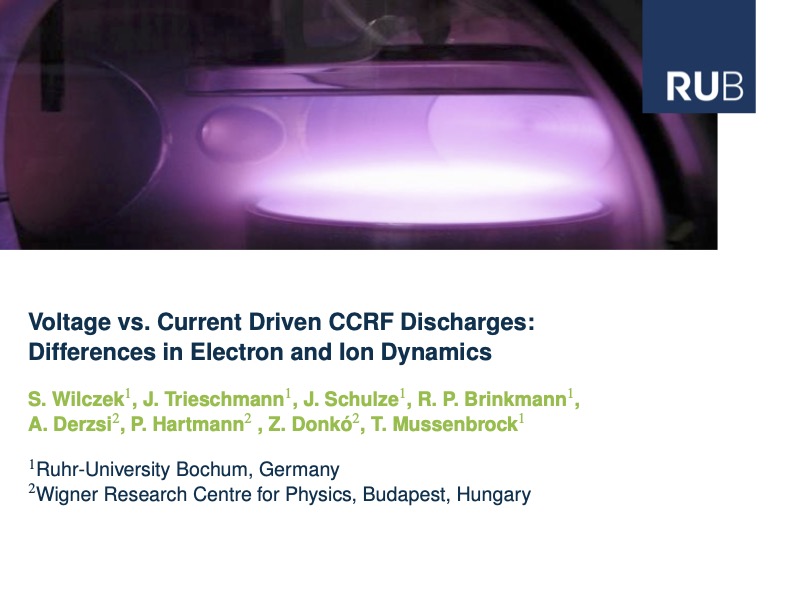
Abstract:
In numerical simulations of capacitively coupled radio frequency (ccrf) discharges the following fundamental question is unanswered: What are the implications of driving the discharge with a sinusoidal current source vs.\ a sinusoidal voltage source? Several analytical models as well as simulations use current sources as boundary conditions. Especially at low pressures, however, the theory of the self-excitation of the plasma series resonance (PSR) by the nonlinearity of the plasma sheath is eliminated when using a current source (as no harmonics in the current are allowed). In contrast, a sinusoidal voltage source can strongly enhance the power dissipation via the self-excitation of the PSR (nonlinear electron resonance heating). In this work, we investigate the differences between voltage and current driven sources with respect to the electron and ion dynamics. By means of Particle-In-Cell simulations, we analyze both scenarios for identical input powers coupled into the system. Significant differences are discussed for different parameter sets, e.g. input power (voltage and current amplitude), driving frequency and pressure.
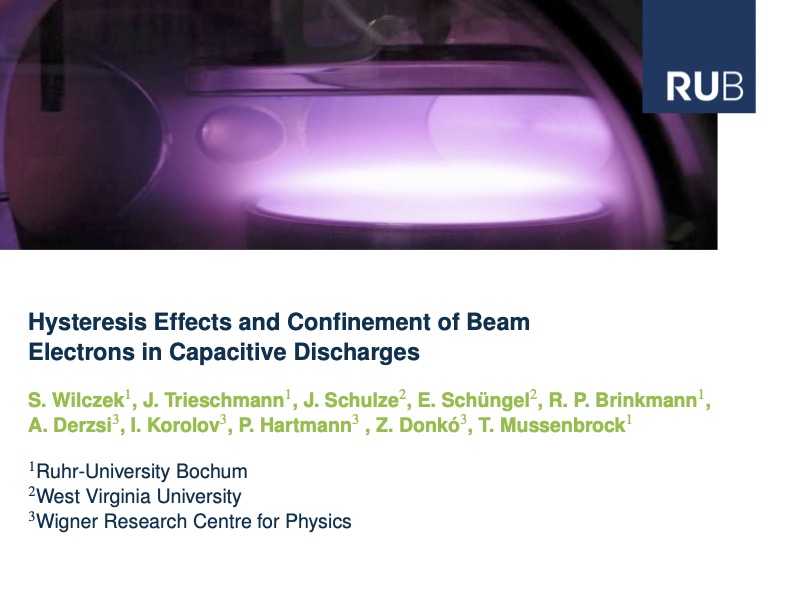
Abstract:
In low-pressure capacitive discharges the radio-frequency modulated plasma sheaths generate a number of highly energetic beam electrons traversing the discharge gap. These electrons are important for sustaining the plasma via ionization. In this work, we investigate the dynamics of these electron beams as well as their effect on the plasma by means of Particle-In-Cell simulations for different process parameters (driving frequency, gap size, pressure). Especially at low pressures (large electron mean free path) and small gap sizes, the interaction of electron beams with the opposing sheath becomes important1. Under a certain combination of parameters, electron beams generated at one electrode can approach the other electrode, when the local sheath length is minimum. These energetic electrons can overcome the sheath potential at this time and can be lost at this electrode. In that case, the plasma density decreases abruptly. Varying the process parameters (e.g., increasing or decreasing the driving frequency) indicates a hysteresis at this abrupt transition. In order to explain this hysteresis, the electron dynamics is investigated on a nanosecond timescale. From these results it is shown that the interaction of beam and bulk electrons is the governing mechanism. 1. S. Wilczek et al.“ The effect of the driving frequency on the confinement of beam electrons and plasma density in low-pressure capacitive discharges”, 2015 Plasma Sourc. Sci. Technol. 24 024002
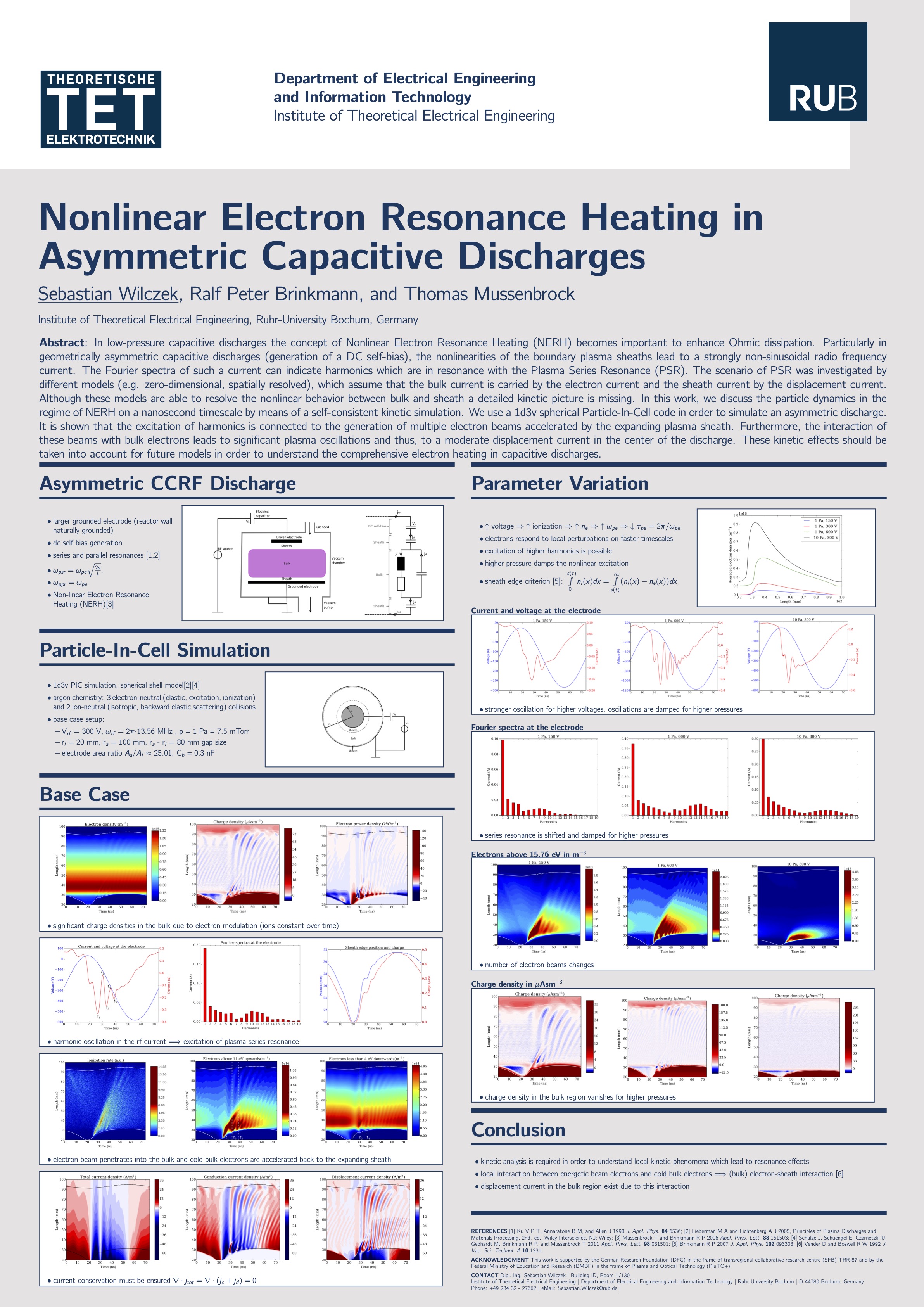
Abstract:
In low-pressure capacitive discharges the concept of Nonlinear Electron Resonance Heating (NERH) becomes important to enhance Ohmic dissipation. Particularly in geometrically asymmetric capacitive discharges (generation of a DC self-bias), the nonlinearities of the boundary plasma sheaths lead to a strongly non-sinusoidal radio frequency current. The Fourier spectra of such a current can indicate harmonics which are in resonance with the Plasma Series Resonance (PSR). The scenario of PSR was investigated by different models (e.g. zero-dimensional, spatially resolved), which assume that the bulk current is carried by the electron current and the sheath current by the displacement current. Although these models are able to resolve the nonlinear behavior between bulk and sheath a detailed kinetic picture is missing. In this work, we discuss the particle dynamics in the regime of NERH on a nanosecond timescale by means of a self-consistent kinetic simulation. We use a 1d3v spherical Particle-In-Cell code in order to simulate an asymmetric discharge. It is shown that the excitation of harmonics is connected to the generation of multiple electron beams accelerated by the expanding plasma sheath. Furthermore, the interaction of these beams with bulk electrons leads to significant plasma oscillations and thus, to a moderate displacement current in the center of the discharge. These kinetic effects should be taken into account for future models in order to understand the comprehensive electron heating in capacitive discharges.
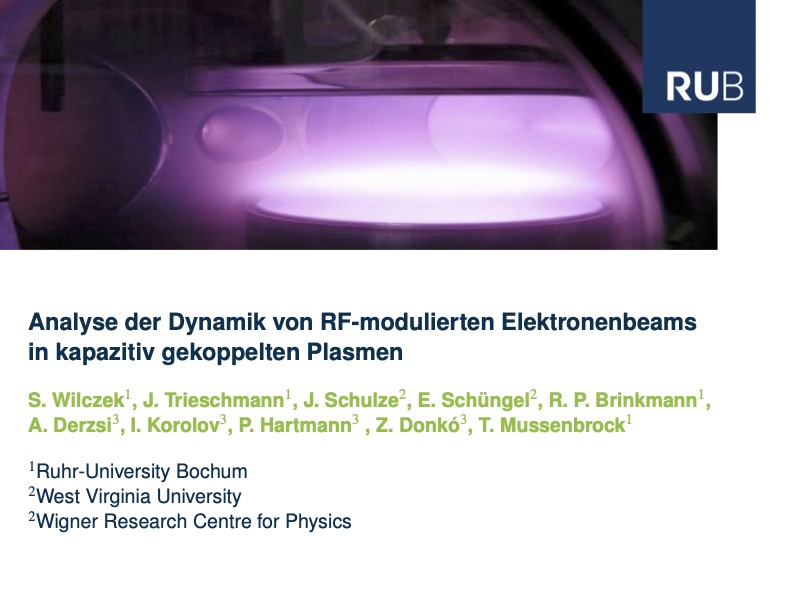
Abstract:
In kapazitiven Niederdruckentladungen ist das Beschleunigen von hochenergetischen Elektronen durch die Randschichtexpansion (Entstehung von Elektronenbeams) einer der wichtigsten Heizungsmechanismen. Der Einfluss von grundlegenden Prozessparametern (z.B. Plattenabstand, Anregungsfrequenz, Druck, Elektrodenanordnung und Elektrodenspannung) kann die Dynamik dieser Elektronenbeams signifikant beeinflussen. Sowohl die Formation als auch die Reflektion an der gegenüberliegenden Randschicht kann durch eine geeignete Wahl dieser Parameter kontrolliert werden. Infolgedessen können prozessrelevante Größen, wie Elektronendichte, Ionenfluss und Verteilungsfunktionen, optimiert werden. In diesem Beitrag werden mithilfe von 1d3v Particle-In-Cell Simulationen Parameterstudien durchgeführt, welche den Einfluss der oben genannten Prozessparameter in Bezug auf die Dynamik der Elektronenbeams und weitere relevante Plasmagrößen bestimmen.
Abstract:
Measuring the plasma parameters has practical importance for controlling a plasma process. A tool for measuring the electron density is the multipole resonance probe (MRP). However, the physical presence of the MRP in the plasma influences the plasma process. In this work an iterative model for determining the coupling between the MRP and the plasma surface is introduced. The electron and ion physics are treated in two coupled models which are iterated until convergence is reached. First results for the potential for a given ion density distribution are presented.
Abstract:
-
Abstract:
-
Abstract:
Active Plasma Resonance Spectroscopy denotes a class of industry-compatible plasma diagnostic methods which utilize the natural ability of plasmas to resonate on or near the electron plasma frequency ωpe. One particular realization of APRS with a high degree of geometric and electric symmetry is the Multipole Resonance Probe (MRP). The Ideal MRP(IMRP) is an even more symmetric idealization which is suited for theoretical investigations. In this work, a spectral kinetic scheme is presented to investigate the behavior of the IMRP in the low pressure regime. However, due to the velocity difference, electrons are treated as particles whereas ions are only considered as stationary background. In the scheme, the particle pusher integrates the equations of motion for the studied particles, the Poisson solver determines the electric field at each particle position. The proposed method overcomes the limitation of the cold plasma model and covers kinetic effects like collisionless damping.
Abstract:
Measuring plasma parameters, e.g. electron density and electron temperature, is an important procedure to verify the stability and behavior of a plasma process. For this purpose the multipole resonance probe (MRP) represents a satisfying solution to measure the electron density. However the influence of the probe on the plasma through its physical presence makes it unattractive for some processes in industrial application. A solution to combine the benefits of the spherical MRP with the ability to integrate the probe into the plasma reactor is introduced by the planar model of the MRP (pMRP). Introducing the spectral kinetic formalism leads to a reduced simulation-circle compared to particle-in-cell simulations. The model of the pMRP is implemented and first simulation results are presented.
Abstract:
In most PIC simulations of capacitively coupled plasmas (CCPs), only an ion induced constant secondary electron emission coefficient, γ, is used, which is usually guessed to be 0.1. Similarly, a constant electron reflection coefficient, ρ, is typically used and assumed to be 0 - 0.2. Here, we utilize an ion and atom induced energy-dependent γ for ``dirty'' and ``clean'' surfaces in a single frequency 13.56 MHz CCP. Its effects on electron heating mode transitions are analyzed as a function of pressure. By utilizing the same energy-dependent γ, its effects on the separate control of the ion flux and mean ion energy are studied for a dual frequency (df) CCP with frequencies of 2 and 27 MHz. The results are compared to multiple simulations with constant γ and significant differences are found. Finally, ρ is varied in a single frequency CCP and its effects on plasma parameters such as the sheath width and electron density are studied. Strong effects of using different reflection probabilities at both electrodes on the discharge symmetry are found. A df CCP is modeled to understand the coupling between the electrical asymmetry effect (EAE) and a discharge asymmetry induced by different electron reflection coefficients for the two electrodes.
Abstract:
Die Messung von Plasmaparametern wie Elektronendichte und -temperatur während eines Plasmaprozesses ist eine wichtige Voraussetzung für eine Prozesssteuerung oder eine -überwachung. Die aktive Plasma-Resonanzspektroskopie (APRS) stellt eine attraktive Diagnostikmethode für eine solche Überwachung dar, bei der die Eigenschaft von Plasmen, in der Nähe der Plasmafrequenz in Resonanz zu geraten, ausgenutzt wird. Eine spezielle Bauform dieser Diagnostikmethode ist die planare Multipol-Resonanz-Sonde (pMRP). Um mit ihr aus einem gemessenen Spektrum Plasmaparameter zu berechnen, wird eine Relation zwischen Resonanzfrequenzen und Plasmaparametern benötigt. Ein möglicher Ansatz zur Bestimmung der benötigten Relation ist eine spektral-kinetische Simulation der pMRP, die in dieser Arbeit vorgestellt wird. Ähnlich wie bei Particle-In-Cell (PIC) wird bei jedem Zeitschritt aus einer Ladungsverteilung von Superteilchen das Feld und die zugehörige Kraft, sowie anschließend die resultierende Geschwindigkeit und der resultierende Ort der Teilchen berechnet. Der wesentliche Vorteil dieser Methode gegenüber PIC liegt in der gitterfreien Simulation.
Abstract:
Active Plasma Resonance Spectroscopy (APRS) denotes a class of industry-compatible plasma diagnostic methods which utilize the natural ability of plasmas to resonate on or near the electron plasma frequency ωpe. The Multipole Resonance Probe (MRP) is a particular realization of APRS with a high degree of geometric and electric symmetry. The Ideal MRP(IMRP) is an even more symmetric idealization of that probe which is particularly suited for theoretical investigations. It consists of two hemispherical electrodes which dielectrically shielded from the plasma. In this contribution, a spectral kinetic scheme is presented to investigate the behavior of the IMRP in the low pressure regime. The scheme consists of two modules, the particle pusher and the field solver. The particle pusher integrates the equations of motion for the studied particle ensemble over a suitable time interval Δt. The Poisson solver, unlike the well-known particle-in-cell (PIC), determines the electric field at each particle position without employing a numerical grid. The proposed method overcomes the limitations of the cold plasma model and covers kinetic effects like collision-less damping.
2015
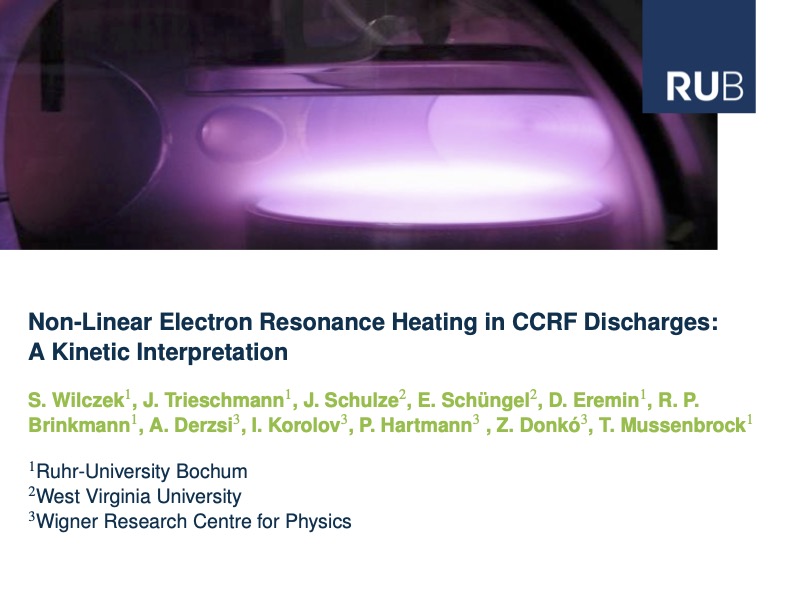
Abstract:
In this work, the physical origin of non-linear electron resonance heating in capacitively coupled radio frequency discharges is investigated using Particle-in-Cell/Monte Carlo Collisions simulations. A detailed kinetic description of the electron dynamics is used to explain the mechanism of the excitation of harmonics in the rf current. It is shown that, especially at low pressures, highly energetic electrons are accelerated by the modulated plasma sheath and leave behind a positive space charge close to the sheath edge. Consequently, cold bulk electrons are attracted back towards this electron depleted zone. After a short time interval (defined by the local plasma frequency), bulk electrons reach the expanding sheath phase, are reflected, and gain energy forming a new energetic electron beam. Since such electron beams represent the major part of the conduction current, this mechanism leads to harmonics in the rf current. Finally, the question ``In which way current continuity is ensured at all the times?'', is answered.
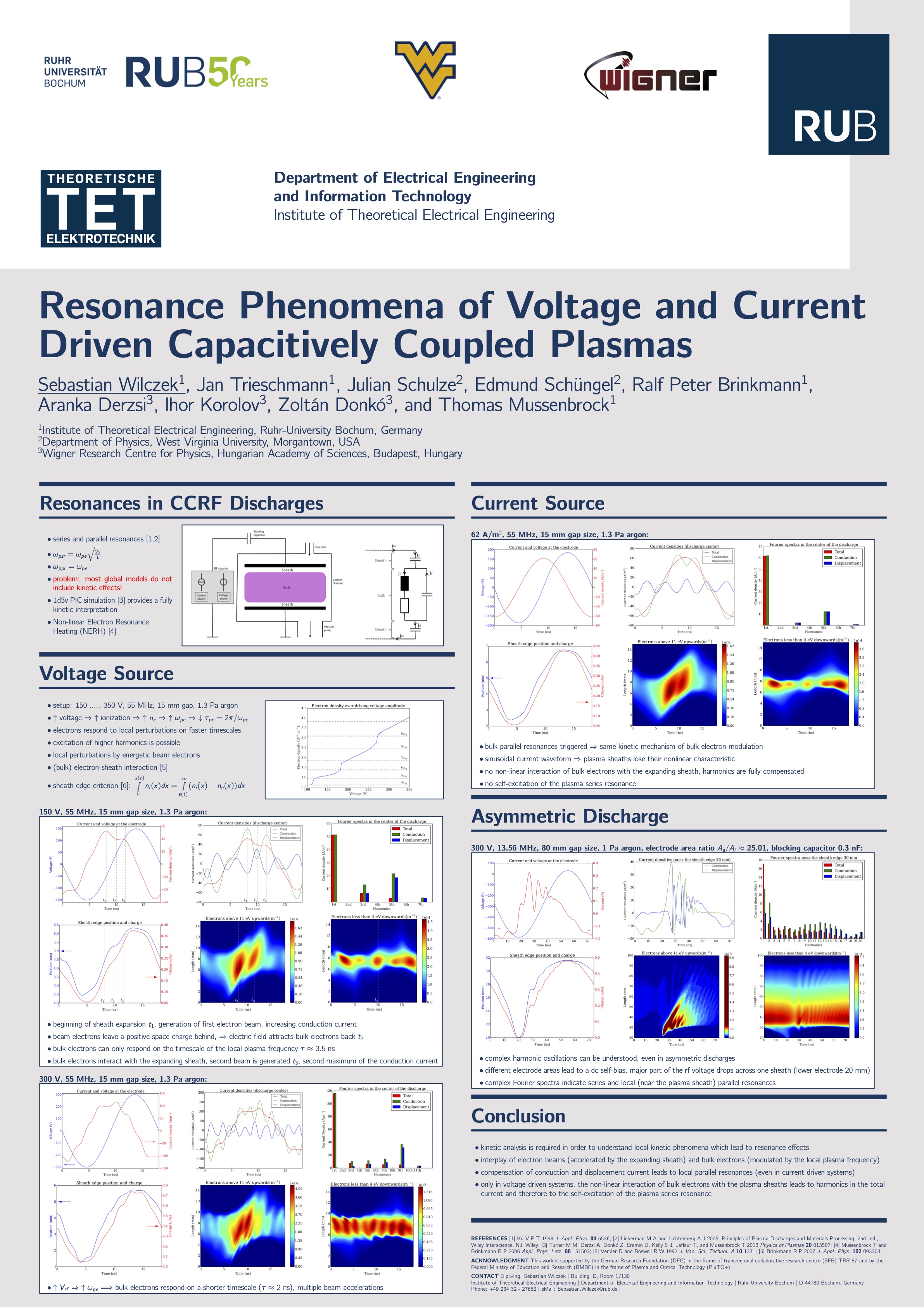
Abstract:
The plasma series resonance is a fundamental phenomenon due to the nonlinear interaction between the plasma bulk and the sheaths of a capacitive discharge. It has been proven to play an important role in the context of electron heating. Furthermore, recent results indicate that the manifestation of harmonics in the plasma current due to the plasma series resonance is responsible for a nonlinear standing wave effect and, consequently, spatial inhomogeneities in the power deposition. It is important to note that the plasma series resonance is a current governed resonance and that it can only be excited in voltage driven systems. Particle-In-Cell simulations however show that also in current driven systems resonances can occur due to the non-linear excitation of harmonics in the conduction and displacement current. In this work, the differences between voltage and current driven capacitive discharges in terms of their nonlinear behavior are investigated. It is found that under certain conditions nonlinear plasma parallel resonances are excited which are able to support the electron heating.
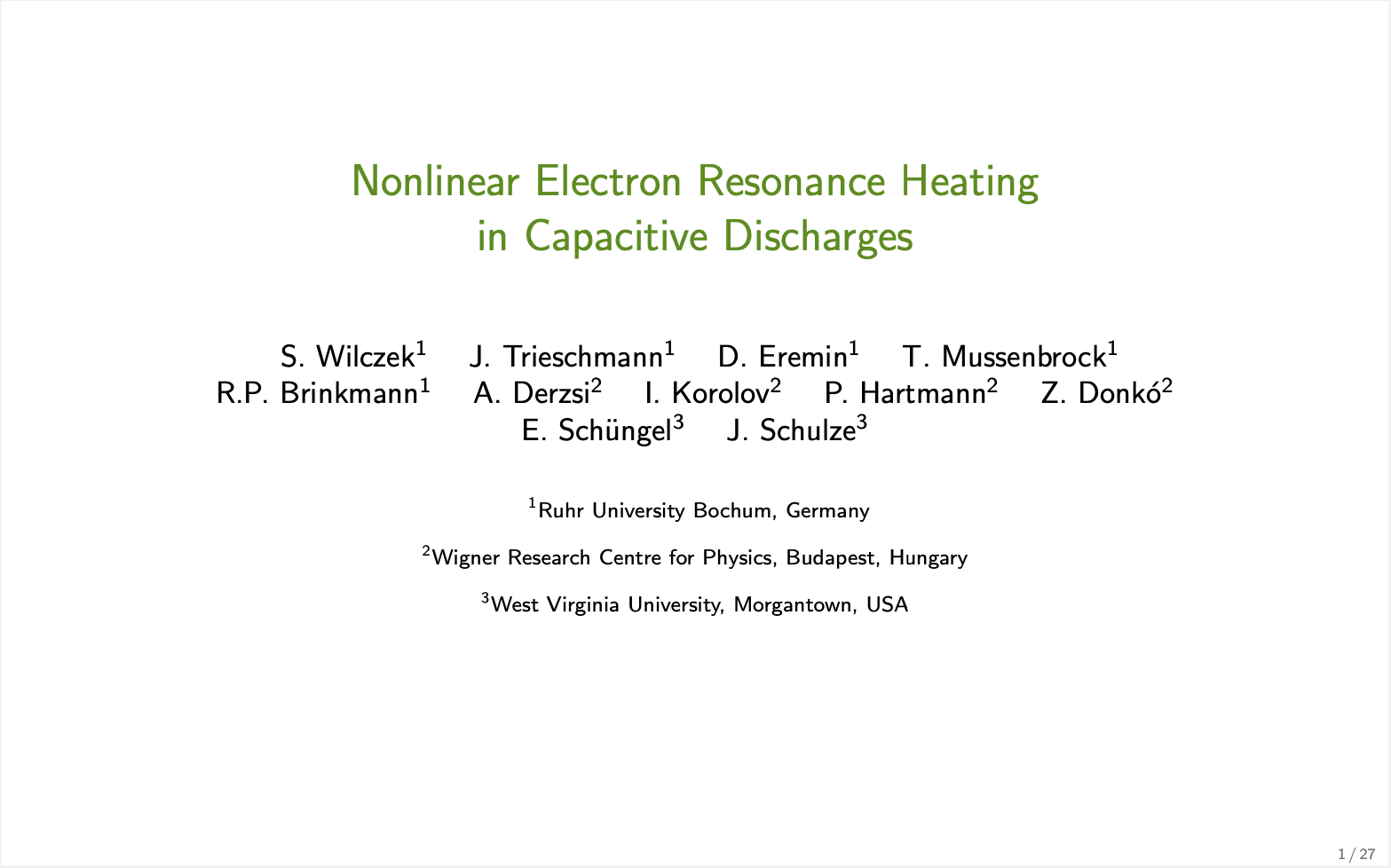
Abstract:
Capacitively coupled radio-frequency discharge for technological applications are frequently operated at relatively low gas pressures. One specific feature of this regime is that collisions of the electrons with the atoms or molecules of the neutral background gas are infrequent. Consequently, the collisional (or Ohmic) heating ceases to be an efficient mechanism of energy deposition into the plasma. In fact, reality shows that under such low pressure conditions the plasma can be sustained, which indicates that there must be alternative mechanisms of electron heating. Almost 40 years of intense research in the field of capacitive discharges have brought substantial insight into the phenomenon of this ``anomalous'' heating mechanism. However, its exact nature is still under discussion. In this work we revisit different notions in the context of anomalous electron heating, e.g., Ohmic, stochastic, and nonlinear electron resonance heating, and discuss the phenomena using global models. Although such models are able to resolve the nonlinear (and even spatially resolved) dynamics of the discharge, they are of course not qualified to bring the actual physical origin of anomalous electron heating to light. To fill this gap, self-consistent kinetic simulations have been conducted. Here, in particular, we report on results that allow deep insight into the physical origin of electron heating due to resonances. For the first time we show that nonlinear electron resonance heating is present in symmetric discharges, not only -- as reported up to now -- in asymmetric discharges.
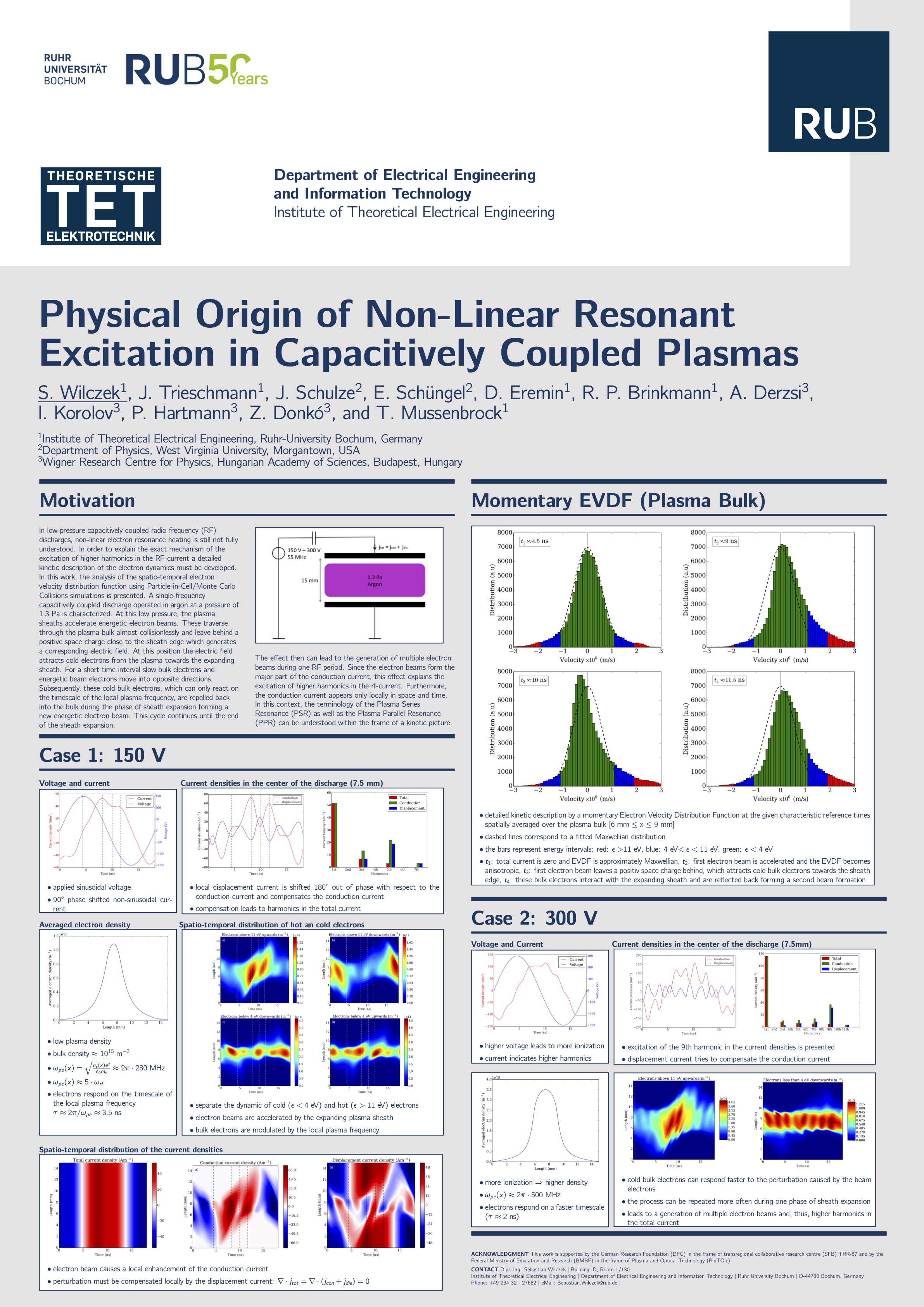
Abstract:
In low-pressure capacitively coupled radio frequency (RF) discharges, non-linear electron resonance heating is still not fully understood. In order to explain the exact mechanism of the excitation of higher harmonics in the RF-current a detailed kinetic description of the electron dynamics must be developed. In this work, the analysis of the spatio-temporal electron velocity distribution function using Particle-in-Cell/Monte Carlo Collisions simulations is presented. A single-frequency capacitively coupled discharge operated in argon at a pressure of 1.3 Pa is characterized. At this low pressure, the plasma sheaths accelerate energetic electron beams. These traverse through the plasma bulk almost collisionlessly and leave behind a positive space charge close to the sheath edge and, consequently, an electric field. At this position the electric field attracts cold electrons from the plasma towards the expanding sheath. For a short time interval slow bulk electrons and energetic beam electrons move into opposite directions. Subsequently, these cold bulk electrons, which can only react on the timescale of the local plasma frequency, are repelled back into the bulk during the phase of sheath expansion forming a new energetic electron beam. This cycle continues until the end of the sheath expansion. The effect then can lead to the generation of multiple electron beams during one RF period. Since the electron beams form the major part of the conduction current, this effect explains the excitation of higher harmonics in the rf-current. Furthermore, the conduction current appears only locally in space and time. As such, to ensure current continuity at any given time, it is naturally compensated by a local displacement current. In this context, the terminology of the Plasma Series Resonance (PSR) as well as the Plasma Parallel Resonance (PPR) can be understood within the frame of a kinetic picture.

Abstract:
In capacitively coupled radio frequency (CCRF) discharges at low pressures the electron heating is dominated by electron interaction with the plasma sheath. Especially the beams of the highly energetic electrons (of which the energy is much higher than the ionization threshold of the background gas), accelerated by the expanding plasma sheaths, play a major role to sustain the plasma. At very low pressures when the electron mean free path is comparable or larger than the gap size, electron beams traverse through the bulk with hardly any collision and interact with the opposing sheath. At a certain combination of the driving frequency, the gap size and the gas pressure of the discharge, electron beams can hit the opposing sheath near its collapse. In this case, most of the highly energetic electrons can overcome the sheath potential and are lost to the electrodes. Additionally multiple beams can be generated during one phase of sheath expansion. In this work we present the effect of changing the driving frequency on the plasma density and the electron dynamics in an argon ccrf discharge. The effect is investigated by means of "Particle-in-Cell/Monte Carlo Collisions" simulations. Based on an analytical power balance model, the confinement quality and the related modulation of the energy loss per electron lost at the electrode are demonstrated. In contrast to previous assumptions, the plasma density does not follow a quadratic dependence on the driving frequency. Instead, a step-like increase at a distinct frequency is observed. In this case most of the highly energetic electrons hit the opposing sheath during its collapse.
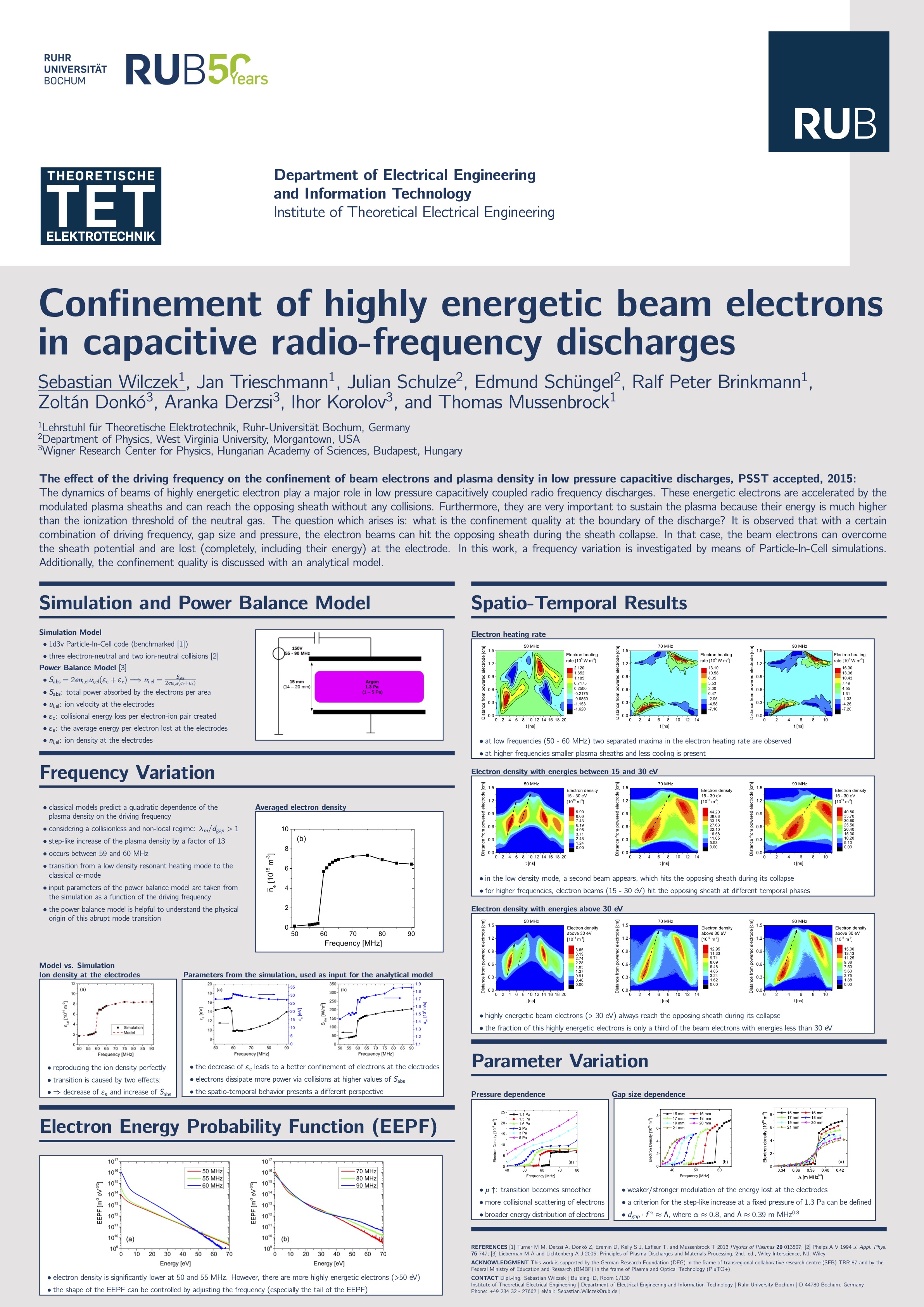
Abstract:
Die Dynamik von hochenergetischen Beamelektronen spielt in kapazitiven Hochfrequenz-Entladungen vor allem bei geringen Drücken eine wichtige Rolle. Diese gerichteten Elektronen werden durch die Randschichtexpansion beschleunigt und können bei einem geringen Elektrodenabstand ohne Stöße die gegenüberliegende Randschicht erreichen. Da die Energie der Beamelektronen durchaus größer ist, als die Ionisationsgrenze diverser Gase, sind diese essentiell wichtig, um das Plasma aufrecht zu erhalten. Es stellt sich somit die Frage, wie die Einschlussqualität für Elektronen an den Grenzflächen der Entladung ist. Bei einer geeigneten Wahl von Anregungsfrequenz, Plattenabstand und Druck können die Beamelektronen so beschleunigt werden, dass der Beam das Minimum der gegenüberliegenden oszillierenden Randschicht trifft. In diesem Fall überwinden die Beamelektronen das Randschichtpotential und gehen samt ihrer Energie an der Elektrode verloren. In dieser Arbeit wird im Rahmen von Particle-In-Cell Simulationen eine Frequenzvariation durchgeführt, um anschließend die Einschlussgüte der Elektronen über ein analytisches Modell zu diskutieren.
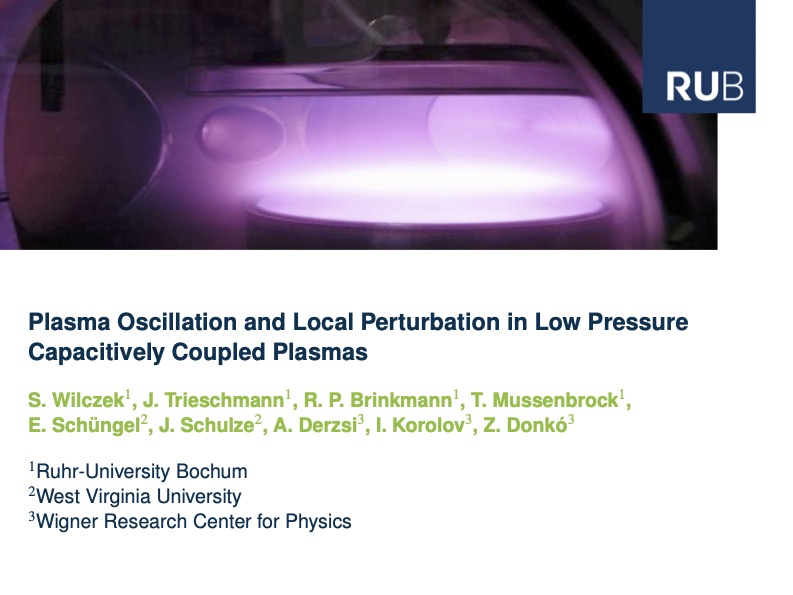
Abstract:
In kapazitiv gekoppelten Plasmen wird eine Wechselspannung zwischen den Elektroden angelegt, welche mit einer Frequenz von 1 bis 100 MHz oszilliert. In diesem RF-Regime können nur die Elektronen aufgrund ihrer geringen Masse den von Außen angelegten elektrischen Feldern folgen. Die schweren Ionen hingegen reagieren nur auf das zeitlich gemittelte elektrische Feld. Neben der Anregungsfrequenz gibt es noch eine weitere charakteristische Frequenz, welche die Oszillation der Elektronen vor einem ruhenden Ionenhintergrund beschreibt, die Elektronenplasmafrequenz. Diese kann bei sehr geringen Plasmadichten die Größenordnung der Anregungsfrequenz erreichen. Trifft in diesem Regime beispielsweise die lokale Plasmafrequenz ein Vielfaches der Anregungsfrequenz, kann es zu lokalen Störungen in der Entladung kommen, bei denen sich signifikante Felder im Plasmabulk einstellen. In dieser Arbeit werden im Rahmen von Particle-In-Cell Simulationen solche Störungen im Niederdruckbereich untersucht. Es ist zu erkennen, dass diese Störungen signifikante Auswirkungen auf die stochastische Heizung von hochenergetischen Elektronen haben.
Abstract:
An immediate question in numerical simulations of capacitive coupled radio frequency (ccrf) discharges is: What is the influence of the driving source in current vs. voltage driven discharges? Especially, the theory of the self-excitation of the plasma series resonance (PSR) by the nonlinearity of the plasma sheath is inconsistent when using a current source. A sinusoidal radio frequency current is coupled into the discharge, and is locally divided into a displacement and a conduction current. Since it is purely sinusoidal, no harmonics in the total current density arise and the self-excitation of the PSR would not be allowed. However, harmonics in the conduction current can still appear. These are locally fully compensated by the displacement current (plasma parallel resonance). In this work the spatio-temporal distribution of the conduction and the displacement current density is investigated comparing the influence of a voltage and a current source. Significant differences between both sources are discussed in detail in conjunction with resonance phenomena and nonlinear electron dynamics. The results are calculated by means of Particle-In-Cell simulations.
Abstract:
The term Active plasma resonance spectroscopy (APRS) is a well known plasma diagnostic method which utilize the natural ability of plasmas to resonate on or near the electron plasma frequency. The idea of APRS is to couple a RF signal into the plasma via a probe and to measure the response of the signal in a certain frequency range. Absorption peaks are identified where electrons resonate. Then a specific mathematical model is used to determine some important plasma parameters such as electron density ne or electron temperature Te. Based on APRS, an economical and industry compatible plasma diagnostic device has been proposed, which is so-called Multipole Resonance Probe (MRP). The Ideal MRP is a geometrically simplified version of that probe, which consists of two dielectrically shielded, hemispherical electrodes. To understand the behavior of this probe in low pressure regime, the spectral kinetic scheme is presented which enables a kinetic simulation of the interaction of the probe with the plasma. It contains of two modules, particle pusher and field solver. The particle pusher integrates the equations of motion for the studied particle ensemble over a suitable time interval △t, i.e., pushes them along their trajectories into the future t+△t. The field solver, unlike the well-known particle-in-cell (PIC), determines the electric field at each particle position without employing the numerical gird. The presented method is expected to cover the limitation of the cold plasma model.
Abstract:
-
Abstract:
The term Active Plasma Resonance Spectroscopy (APRS) denotes a class of diagnostic techniques which utilize the natural ability of plasmas to resonate on or near the electron plasma frequency: An RF signal in the GHz range is coupled into the plasma via an electric probe; the spectral response of the plasma is recorded, and a mathematical model is used to determine plasma parameters such as the electron density ne or the electron temperature Te. One particular realization of the method is the Multipole Resonance Probe (MRP). The ideal MRP is a geometrically simplified version of that probe; it consists of two dielectrically shielded, hemispherical electrodes to which the RF signal is applied. A particle-based numerical algorithm is described which enables a kinetic simulation of the interaction of the probe with the plasma. Similar to the well-known particle-in-cell (PIC), it contains of two modules, a particle pusher and a field solver. The Poisson solver determines, with the help of a truncated expansion into spherical harmonics, the new electric field at each particle position directly without invoking a numerical grid. The effort of the scheme scales linearly with the ensemble size N.
Abstract:
Das kontinuierliche Monitoring von Plasma-Parametern, z.B. der Elektronendichte und der Elektronentemperatur, bietet vielversprechende Ansätze zur Überwachung und Regelung von industriellen Plasmaprozessen. Für diesen Zweck wurde mit der Multipol-Resonanz-Sonde(MRP) im Rahmen eines BMBF Projekts (PluTO) eine Diagnostik entwickelt. Eine besonders attraktive Ausführung stellt die sogenannte planare MRP dar, die aufgrund ihrer kompakten Bauweise in der Reaktorwand befestigt werden kann und somit keine lokale Störung im Plasma bewirkt. Dieser Beitrag präsentiert erste Ansätze zur Modellierung der MRP mit den Methoden der kinetischen Theorie, die im Gegensatz zu fluiddynamischen Modellen, nicht nur eine Messung der Elektronendichte, sondern auch der Elektronentemperatur erlauben sollte.
2014
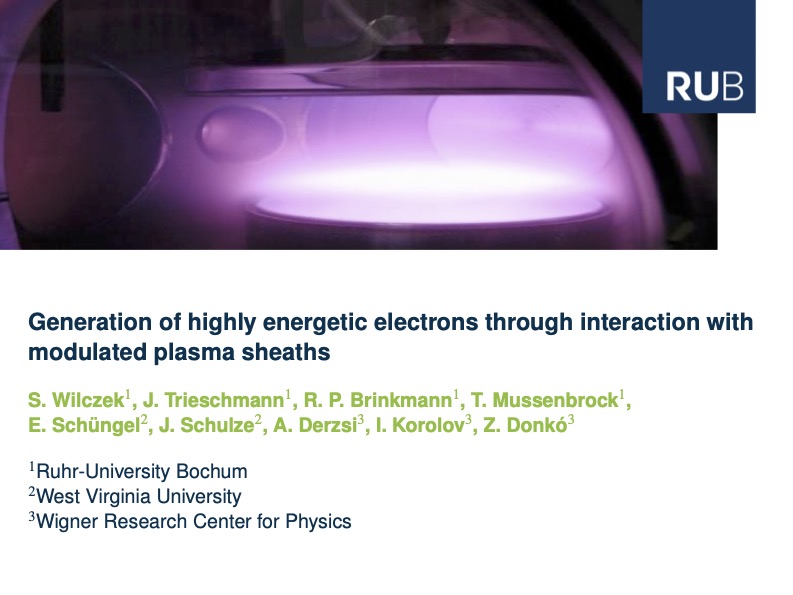
Abstract:
In capacitively coupled radio frequency discharges a fraction of electrons is accelerated due to the expansion of the modulated plasma sheath. Especially at low pressures, these beam-like electrons have energies much higher than the ionization threshold and are very important to sustain the plasma. This effect is persistent, even if secondary electron-emission is excluded. Under distinct discharge conditions the electron beams disturb the plasma bulk drastically, which leads to a violation of quasi-neutrality. Consequently, strong electric fields exist even in the center of the discharge. In this work, the formation of highly energetic electrons is investigated by means of 1d3v Particle-In-Cell simulations. It is shown that the number of electron beams as well as the modulation of the plasma sheaths can be modified with tuning the driving voltage amplitude. Additionally, the excitation at frequencies close to the local electron plasma frequency plays a major role in conjunction with local resonance phenomena.
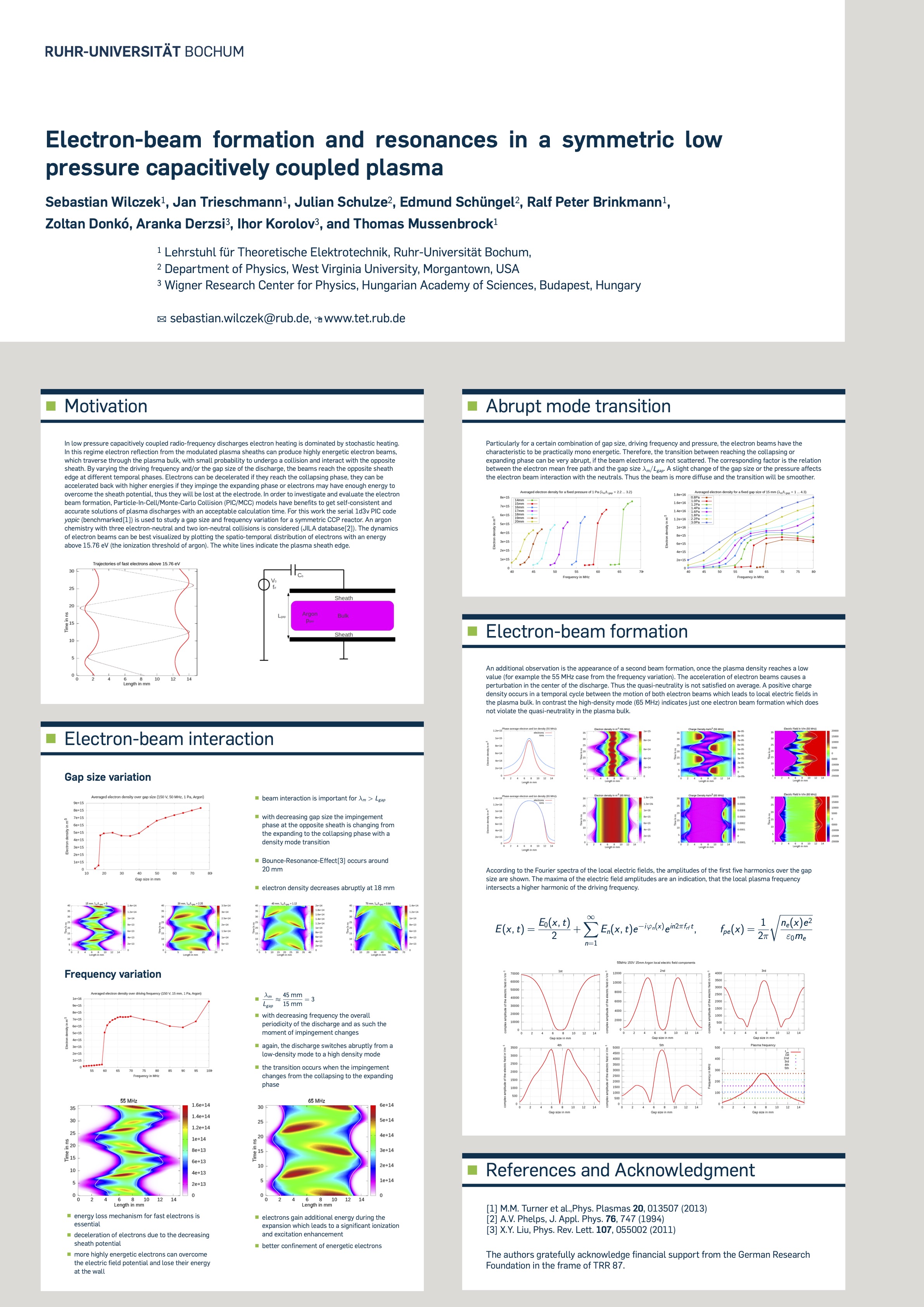
Abstract:
In low pressure capacitively coupled radio frequency (CCRF) discharges, the optimization of technological processes, such as sputtering, etching and plasma enhanced chemical vapor deposition requires an essential understanding of the electron dynamics. This is because electrons with a specific energy threshold, e.g., ionization energy, are responsible for the generation of positive ions and radicals. Therefore, the most important question is, how do electrons gain and lose their energy in this regime? In this low pressure regime, the discharge operates in a very ‘nonlocal’ regime. Electrons interact with the space- and time dependent electric field and traverse a certain distance (electron mean free path) collisionlessly. Consequently, the local electron velocity distribution function becomes anisotropic and the discharge exhibits complex electron dynamics, such as nonlinear effects and resonance phenomena. In the last 50 years, various terminologies have been introduced which are based on theoretical, experimental and computational work in order to study the electron power absorption at low pressure, e.g., stochastic heating, nonlinear electron resonance heating, bounce resonance heating, pressure heating, ambipolar heating, wave-particle-heating and many more.
Abstract:
At very low gas pressures around 1 Pa the electron heating in capacitive radio frequency discharges is dominated by stochastic heating. In this regime electrons are accelerated by the oscillating sheaths, traverse through the plasma bulk and interact with the opposite sheath. Depending on the driving frequency the energetic electrons can enter the sheaths at different phases. These are i) the collapsing phase when the electrons are decelerated, ii) the expanding phase when they are accelerated, and iii) the instant of time, when the sheath width has its minimum and energetic electrons may reach the electrode and be lost. This work analyzes the resulting complex discharge dynamics by means of Particle-In-Cell simulation. It is shown that at certain frequencies the discharge switches abruptly from a low-density mode in a high-density mode. The inverse transition is also abrupt, but shows a significant hysteresis. This phenomenon is explained by the complex interaction of the bulk and the sheath.
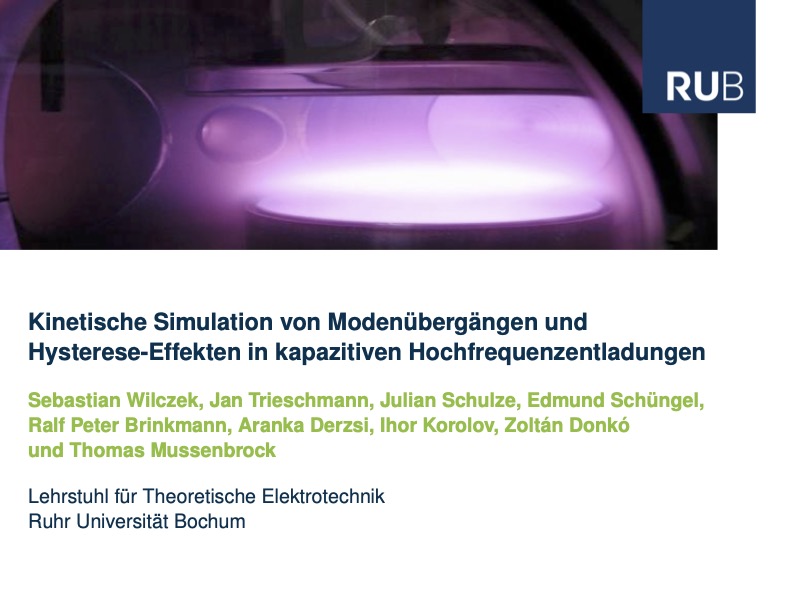
Abstract:
In kapazitiv gekoppelten Hochfrequenz-Niederdruckplasmen treten in Abhängigkeit von der Kombination unterschiedlicher äußerer Parameter eine Vielzahl kinetischer Effekte auf. Ein wichtiger Mechanismus ist die stochastische Heizung. Elektronen wechselwirken mit der hochfrequent oszillierenden Randschicht und gewinnen im Mittel kinetische Energie. Für die Wechselwirkung spielt der Auftreffzeitpunkt der Elektronen die entscheidende Rolle. Ob die Elektronen die Randschicht erreichen während diese kollabiert oder expandiert, kann über die Anregungsfrequenz und den Elektrodenabstand eingestellt werden. Man hat somit die Möglichkeit, direkten Einfluss auf die stochastische Heizung zu nehmen. Der Beitrag diskutiert abrupte Übergänge von Betriebsmodi von kapazitiven Hochfrequenzentladungen, die im Rahmen von Particle-in-Cell-Simulationen beobachtet werden. Eine kleine Veränderung der Anregungsfrequenz führt u.U. zu einer drastischen Erhöhung der Elektronendichte. Es wird gezeigt, dass die unterschiedlichen Betriebsmodi bestimmten Hystereseeffekten unterliegen.

Abstract:
In kapazitiven Hochfrequenzentladungen verursacht das sich zeitlich ändernde elektrische Feld zwischen den Elektroden eine Stromdichte, die durch die gesamte Entladung fließt. Unter normalen Bedingungen ist die Stromdichte in der Randschicht getragen durch die dielektrische Verschiebung, während die Stromdichte im Plasmabulk im Wesentlichen eine Leitungsstromdichte darstellt. Unter bestimmten Bedingungen zeigt der Plasmabulk allerdings eine signifkante periodische Störung der Quasineutralität, so dass auch hier ein nicht zu vernachlässigender Anteil der Stromdichte eine Verschiebungsstromdichte ist. Im Rahmen von Particle-In-Cell-Simulationen wird diese Störung der Quasineutralität durch die Anregung von Beams schneller Elektronen durch die nichtharmonisch oszillierende Randschicht hervorgerufen. Der Beitrag diskutiert den physikalischen Mechanismus der Beam-Erzeugung, der letztendlich als ein Resonanzeffekt identifiziert wird.
2013
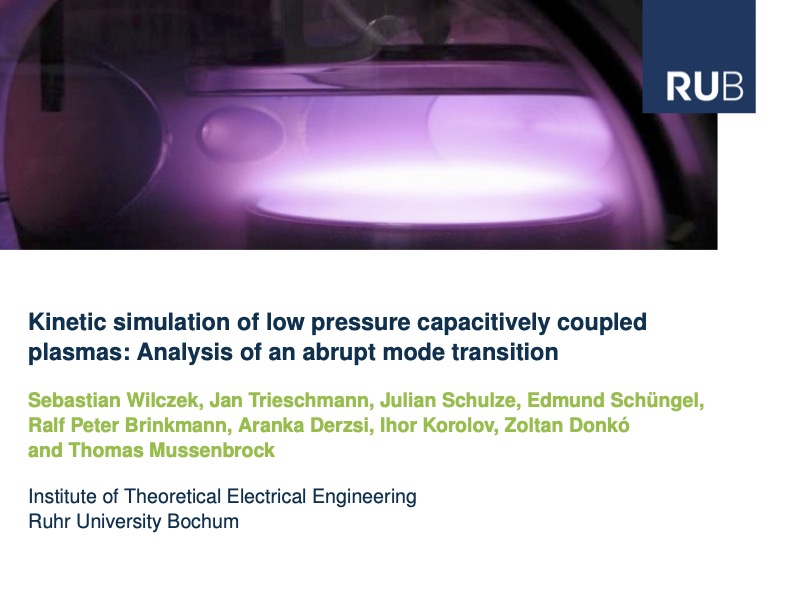
Abstract:
In low pressure capacitively coupled radio-frequency discharges electron heating is dominated by stochastic heating. By using 1D3V Particle-in-Cell simulations it is shown that the interaction of electrons with and reflection from the sheaths can produce highly energetic electron beams. Due to a low collisionality, these beams can traverse through the plasma bulk and interact with the opposite sheath without any collision. By varying the driving frequency or the gap size, the relative phase between the electron beam impact on the opposite sheath and the movement of the latter can be adjusted. Therefore the reflection of the beams can be strongly influenced. Only weak interaction is observed when the electron beam impinges the opposite sheath in its collapsing phase. However, once the electron beam impinges the opposite sheath in the expanding phase, an abrupt electron heating mode transition is observed for a distinct combination of gap size and driving frequency. This transition is complimented by the appearance of a hysteresis of the excited mode depending on the initial discharge conditions. To explain this complex behavior higher harmonics of the driving frequency play an important role.
Abstract:
The electron heating in capacitive discharges at very low pressures (~ 1 Pa) is dominated by stochastic heating. In this regime electrons are accelerated by the oscillating sheaths, traverse through the plasma bulk and interact with the opposite sheath. By varying the driving frequency or the gap size of the discharge, energetic electrons reach the sheath edge at different temporal phases, ie, the collapsing or expanding phase, or the moment of minimum sheath width. This work reports numerical experiments based on Particle-In-Cell simulations which show that at certain frequencies the discharge switches abruptly from a low density mode in a high density mode. The inverse transition is also abrupt, but shows a significant hysteresis. This behavior is explained by the complex interaction of the bulk and the sheath.
Abstract:
-
2012
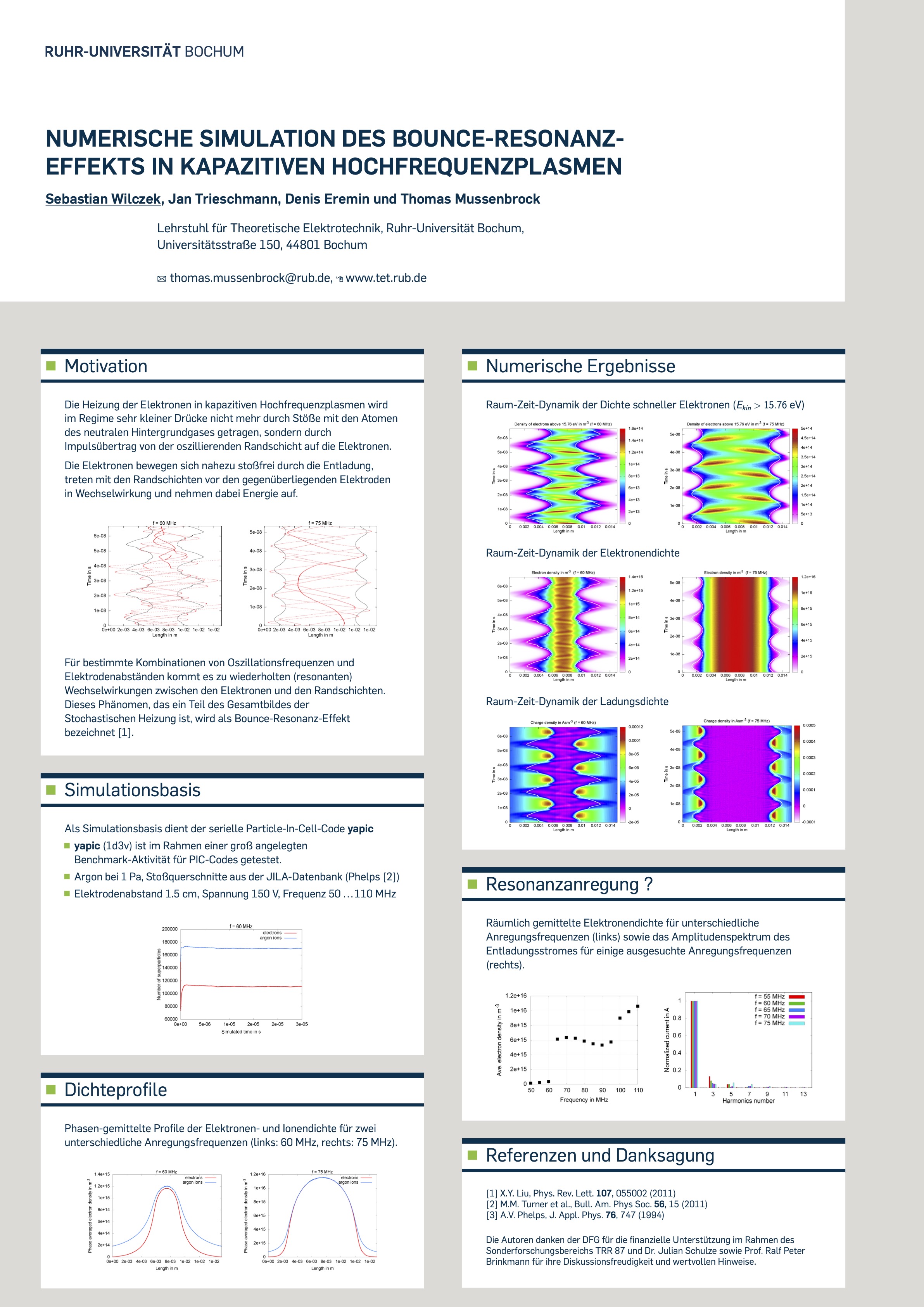
Abstract:
Kapazitive Hochfrequenzplasmen werden zur Oberflächenmodifikation häufig bei extrem niedrigen Gasdrücken betrieben. Die Gasdrücke liegen nicht selten im Bereich zwischen 1 und 5 Pa, wo die Heizung der Elektronen nicht mehr durch Stöße mit den Atomen des neutralen Hintergrundgases (Ohmsche Heizung), sondern durch die stochastische Heizung getragen wird. Hierbei kommt es zum Impulsübertrag von der oszillierenden Randschicht auf die Elektronen. Die jetzt energetischen Elektronen bewegen sich nahezu stoßfrei durch die Entladung und treten mit der Randschicht vor der gegenüberliegenden Elektrode in Wechselwirkung. Für eine bestimmte Kombination von Oszillationsfrequenz der Randschichten und Elektrodenabstand kommt es nun erneut zu einem Impulsübertrag von der Randschicht auf die Elektronen. Die Elektronen gewinnen erneut Energie und bewegen ich zurück. Dieser Effekt, der als Bounce-Resonanz-Effekt bezeichnet wird, wird mittels selbstkonsistenter kinetischen Simulation des Bounce-Resonanz-Effektes beschrieben. Der Beitrag diskutiert den Zusammenhang zwischen Plasmaparametern und dem resonanten Elektrodenabstand. Diese Arbeit wird im Rahmen des SFB-TR 87 durch die Deutsche Forschungsgemeinschaft gefördert.
Abstract:
The electron heating in capacitive high frequency discharges at very low gas pressures is dominated by momentum transfer from the oscillating sheath. In this regime ohmic heating is not sufficient anymore to maintain the plasma. Under certain electric and geometric conditions highly energetic electrons are able to traverse the plasma bulk and interact with the opposite sheath. For proper frequencies and gap sizes the electrons gain energy, accelerate back and resonantly interact with first sheath. The circle may repeat itself. In this contribution the described bounce resonance effect is investigated by means of Particle-In-Cell simulations. It is found that the effect is connected with the excitation of electrostatic waves and the generation of harmonics in the discharge current. It is shown that it is also connected with a very efficient confinement of electrons.